Sensys Networks APCCSPP APCC SPP Digital Radio User Manual
Sensys Networks, Inc APCC SPP Digital Radio Users Manual
Users Manual

Sensys Networks VDS240 Wireless Vehicle
Detection System
Access Point Controller Card Installation Guide
P/N 152-240-030-005 Rev A
April 2011
Sensys Networks
2560 Ninth Street, Suite 219
Berkeley, CA 94710
www.sensysnetworks.com

Access Point Controller Card Installation Guide
Contents
Introduction................................................................................................................................................................. 7
What's Inside...............................................................................................................................................................................7
Other Documents.........................................................................................................................................................................8
Overview...................................................................................................................................................................... 9
Access Point Controller Card (APCC)..........................................................................................................................................9
Contact Closure Expansion Card...................................................................................................................................................................................10
Types of APCC Configurations...................................................................................................................................................10
APCC System..............................................................................................................................................................................................................10
APCC Package Contents............................................................................................................................................................11
SPP Package Contents..............................................................................................................................................................11
Universal Mounting Kit Contents..................................................................................................................................................................................12
Additional Parts and Equipment Required.................................................................................................................................13
Notes.........................................................................................................................................................................................................................14
APCC Installation Considerations.............................................................................................................................. 15
Identifying the SPP, Access Points and Sensors.......................................................................................................................15
SPP...........................................................................................................................................................................................................................15
Access Points.............................................................................................................................................................................................................16
Wireless Sensors.........................................................................................................................................................................................................16
Determining the Device Configuration.......................................................................................................................................16
Configuration Worksheet..............................................................................................................................................................................................16
Determining Slots and Contact Closures ..................................................................................................................................18
Mapping Wireless Sensors to Contact Closures ......................................................................................................................18
SPP Installation Considerations................................................................................................................................ 20
Powering the SPP......................................................................................................................................................................20
Acquiring Power From a Traffic Controller.....................................................................................................................................................................20
Acquiring Power Form Traffic Controller Using an Isolator..............................................................................................................................................21
Voltages.....................................................................................................................................................................................................................22
Cabling......................................................................................................................................................................................................................22
Collecting Data From the APCC.................................................................................................................................................22
Determining the Location of the SPP........................................................................................................................................22
Optimal Location Criteria.............................................................................................................................................................................................23
APCC Installation Procedures.................................................................................................................................... 24
Overview....................................................................................................................................................................................24
Determining the Card ID and Setting it via Circuit-board Dip Switches SW1 and SW2 ............................................................24
Factory Default Card ID...............................................................................................................................................................................................25
Querying the Backplane for an Assigned Address...........................................................................................................................................................25
Setting the Slot-Number With Circuit-board Dip Switch SW2..........................................................................................................................................26
Setting the Shelf-Number With Circuit-board Dip Switch SW1........................................................................................................................................26
Determining the Controller Type and Setting it via Circuit-board Dip Switch SW1 ..................................................................26
Connecting the Cables to Each Device......................................................................................................................................26
Cabling Summary......................................................................................................................................................................27
Sensys Networks, Inc. - 2 -

Access Point Controller Card Installation Guide
SPP Installation Procedures...................................................................................................................................... 29
Tools Required for SPP Installation..........................................................................................................................................29
Step-by-Step Procedures...........................................................................................................................................................30
Installing the Mounting Plate on Poles..........................................................................................................................................................................30
Installing the Mounting Plate on Walls..........................................................................................................................................................................31
Installing the Mounting Plate on Beams........................................................................................................................................................................31
Configuration............................................................................................................................................................. 32
Overview....................................................................................................................................................................................32
Configuration Methods.................................................................................................................................................................................................33
Configuring Channels With the Front-Panel Interface...............................................................................................................33
General Procedure.......................................................................................................................................................................................................33
Enabling / Disabling a Channel.....................................................................................................................................................................................34
Specifying the Channel Mode.......................................................................................................................................................................................35
Setting a Presence Mode Modifier (Optional).................................................................................................................................................................35
Specifying the Type of Communication Used by the Channel Status Monitor....................................................................................................................36
Starting TrafficDot and Connecting to an APCC........................................................................................................................37
Configuring Channels With TrafficDot.......................................................................................................................................38
Opening the Configuration Windows for Controller Cards................................................................................................................................................39
Specifying the Elements of the Configuration................................................................................................................................................................40
Saving the Configuration..............................................................................................................................................................................................43
Other Card Configuration Operations.........................................................................................................................................43
Defining Sensor-to-Channel Mappings......................................................................................................................................43
Exiting TrafficDot.......................................................................................................................................................................45
Appendixes................................................................................................................................................................ 46
Appendix 1 – X Mode LED Displays for Slot Numbers...............................................................................................................47
Appendix 2 – Circuit-board Dip Switch SW1 Settings..............................................................................................................48
Settings for Shelf Number...........................................................................................................................................................................................48
Settings for TS1 and TS2 Controllers............................................................................................................................................................................48
Appendix 3 – Circuit-board Dip Switch SW2 Settings..............................................................................................................49
Settings for Slot Number.............................................................................................................................................................................................49
Appendix 4 – Pre-Installation Worksheets................................................................................................................................50
Sensys Networks, Inc. - 3 -

Access Point Controller Card Installation Guide
Document Properties
This document is reference material for the Sensys Networks VDS240 wireless vehicle detection
system from Sensys Networks, Inc.
P/N 152-240-030-005 Rev A
Sensys Networks, Inc. makes no representation or warranties with respect to the contents hereof
and specifically disclaims any implied warranties of merchantability or fitness for any particular
purpose. Furthermore, Sensys Networks reserves the right to revise this publication and to make
changes from time to time in the content hereof without obligation of Sensys Networks to notify
any person or organization of such revisions or changes.
© 2007 – 2011 – All rights reserved.
Sensys Networks and the Sensys Networks logo are trademarks of Sensys Networks, Inc. All other
products, names and services are trademarks or registered trademarks of their respective owners.
Regulatory Statements
FCC Compliance Statement
This device complies with part 15 of the FCC rules. Operation is subject to the following two
conditions:
(1) This device may not cause harmful interference.
(2) This device must accept any interference received, including interference that may cause
undesired operation.
The users manual or instruction manual for an intentional or unintentional radiator shall caution
the user that changes or modifications not expressly approved by the party responsible for
compliance could void the user's authority to operate the equipment. In cases where the manual is
provided only in a form other than paper, such as on a computer disk or over the Internet, the
information required by this section may be included in the manual in that alternative form,
provided the user can reasonably be expected to have the capability to access information in that
form.
To comply with FCC’s RF exposure limits for general population / uncontrolled exposure, the
antenna(s) used for this transmitter must be installed to provide a separation distance of at least 20
cm from all persons and must not be co-located or operating in conjunction with any other antenna
or transmitter."
Any changes or modifications to this product not authorized by Sensys Networks could void the
EMC compliance and negate the authority to operate the product.
Sensys Networks, Inc. - 4 -

Access Point Controller Card Installation Guide
RF Exposure Statement
This device has been tested and meets the FCC RF exposure guidelines. It should be installed and
operated with a minimum distance of 20 cm between the radiator of RF energy and the body of
users, operators or others.
Improper use or tampering with the device is prohibited and may not ensure compliance with FCC
exposure guidelines.
Warnings
No Safety Switching
Sensys Networks does not allow its equipment to be used for safety applications such as
controlling a mechanical gate or switching a train to avoid a collision.
Lithium Thionyl Chloride Batteries
Sensys Networks uses Lithium Thionyl Chloride batteries in the following products:
•Sensors (VSN240-F, VSN240-T, VSN240-S)
•Repeaters (RP240-B, RP240-BH, RP240-B-LL, and RP240-BH-LL)
Lithium batteries are widely used in electronic products because they contain more energy
per unit -weight than conventional batteries. However, the same properties that deliver
high energy density also contribute to potential hazards if the batteries are damaged.
Improper use or handling of the batteries may result in leakage or release of battery
contents, explosion or fire.
Following are the recommendations of the battery manufacturer for proper use and
handling of batteries in the Sensys Networks devices mentioned above:
•DO NOT charge or attempt to recharge the batteries (batteries are NOT rechargeable)
•DO NOT crush or puncture batteries
•DO NOT short-circuit the batteries
•DO NOT force over-discharge of the batteries
•DO NOT incinerate or expose batteries to excessive heating
•DO NOT expose battery contents to water
•DO dispose of batteries and devices containing batteries in accordance with local
regulations
Note: Sensys Networks wireless sensors contain no serviceable parts and should never be
disassembled. Installation and removal of sensors from pavement should only be done by
trained personnel and care should be taken to insure that the sensor casing is not punctured
or crushed.
Sensys Networks, Inc. - 5 -

Access Point Controller Card Installation Guide
Additional safety information is available from the battery's manufacturer:
•Sensor battery cell: http://www.able-battery.com/msds/ABLE_MSDS_ER14505.pdf
•Repeater battery cell: http://www.able-battery.com/msds/ABLE_MSDS_ER34615.pdf
Document Control
Sensys Networks continually reviews and revises its technical publications Please address
questions, suggestions or corrections to support@sensysnetworks.com.
Contact Information
Sensys Networks, Inc.
2560 Ninth Street, Suite 219
Berkeley, CA 94710 USA
+1 (510) 548-4620
www.sensysnetworks.com
Sensys Networks, Inc. - 6 -

Access Point Controller Card Installation Guide
CHAPTER 1
Introduction
This guide provides information and procedures for installing Sensys Networks Access Point
Controller Card (APCC) and the APCC Serial Port Protocol (SPP) digital radio in conjunction with
the Sensys Networks VDS240 wireless vehicle detection system. This document is intended to be
used by Sensys Networks customers, consultants, partners, dealers, and those who are interested in
the application of wireless communication technology to the challenges of traffic detection,
management and control.
What's Inside
This guide includes the following information:
•Chapter 1: Introduction, defines the purpose and scope of the guide.
•Chapter 2: Overview, provides an overview of the APCC and its additional
components. It also describes the contents of a product shipment.
•Chapter 3: APCC Installation Considerations, provides the installation considerations
for the APCC.
•Chapter 4: SPP Installation Considerations, provides the installation considerations
for the SPP.
•Chapter 5: APCC Installation Procedures, provides instructions for installing and
cabling the APCC.
•Chapter 6: SPP Installation Procedures, provides instructions for installing and
mounting the SPP.
•Chapter 7: Configuration, provides instructions for setting up an APCC for a particular
site.
Sensys Networks, Inc. - 7 -

Access Point Controller Card Installation Guide Introduction
Other Documents
General and Reference Information
•Sensys Networks VDS240 Wireless Vehicle Detection System – System Overview
•Sensys Networks VDS240 Wireless Vehicle Detection System Reference Guide
Freeway and Arterial Applications
•Design Guidelines for Freeway & Arterial Applications
•Configuration Guidelines for Freeway & Arterial Applications
•Installation Guidelines for Freeway & Arterial Applications
Intersection Applications
•Design Guidelines for Intersection Applications
•Configuration Guidelines for Intersection Applications
•Installation Guidelines for Intersection Applications
Installation and Removal Procedures
•Wireless Sensor Installation Guide
•Access Point Installation Guide
•Repeater Installation Guide
Application Notes
•Installing Sensys Networks Sensors Beneath the Road Surface
Sensys Management Server
•SNAPS Server Set Up and Operating Guide
Readers of this document are encouraged to contact Sensys Networks, Inc. for the latest technical
information, design guides, and best practices.
Sensys Networks, Inc. - 8 -
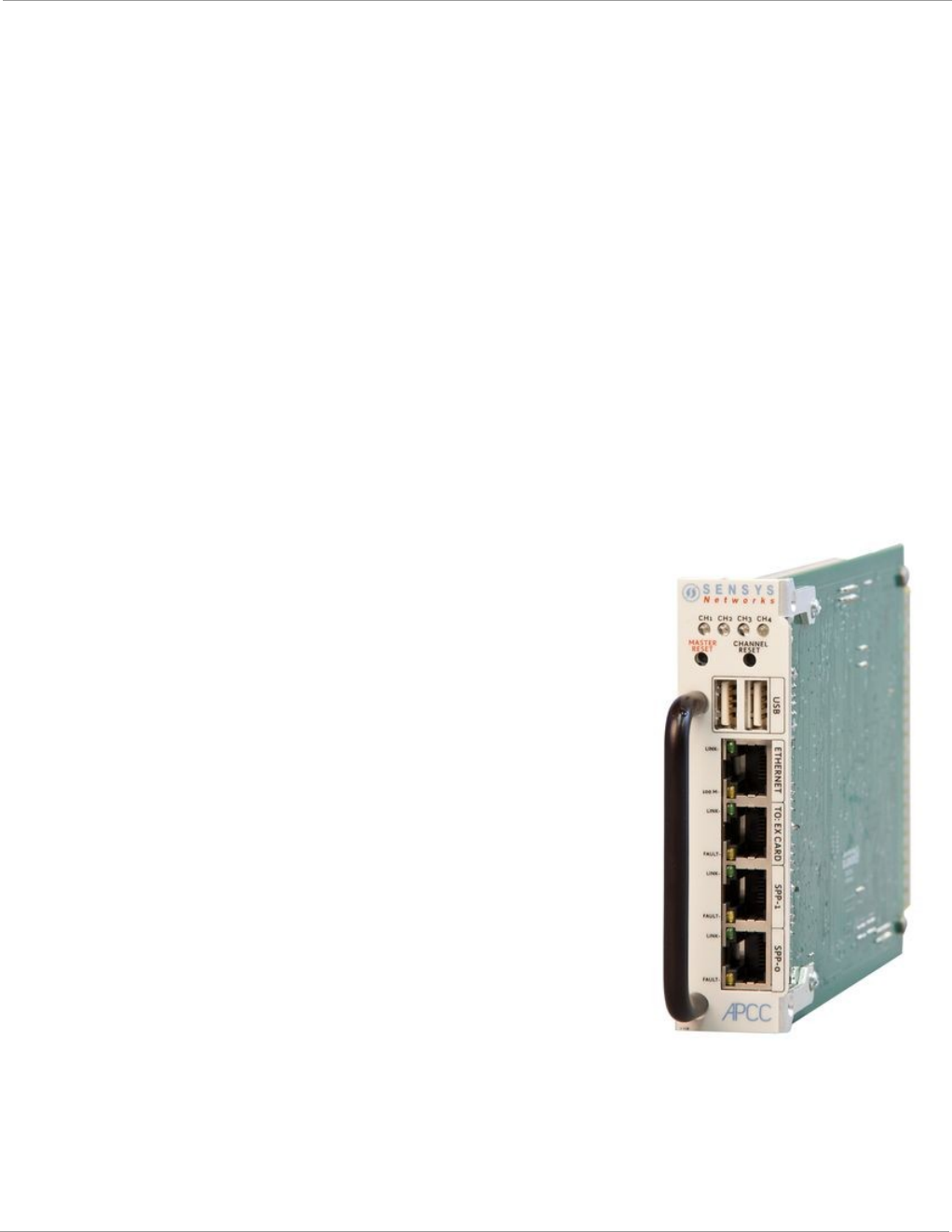
Access Point Controller Card Installation Guide
CHAPTER 2
Overview
This chapter provides an overview of the APCC and its additional components. The chapter also
describes the contents of a product shipment.
Access Point Controller Card (APCC)
The Sensys Networks VDS240 Wireless Vehicle Detection
System detects the presence and movement of vehicles with
magneto-resistive sensors mounted in the pavement.
Wireless sensors continuously transmit detection data to
access points that collect and forward data to remote traffic
management systems or local traffic signal controllers such
as the CalTrans Type 170, Type 2070 ATC and NEMA TS-1
and TS-2 controllers.
The Sensys Networks Access Point Controller Card (APCC),
is a second generation controller card that maintains low
power consumption, supports multiple radios, and allows
for additional communication and processing power. The
APCC, which is compatible with all of Sensys Networks
VDS240 Wireless Vehicle Detection System products,
receives and processes data from the sensors. The APCC
then relays the sensor detection data to a roadside traffic
controller or remote server traffic management system.
Sensys Networks, Inc. - 9 -
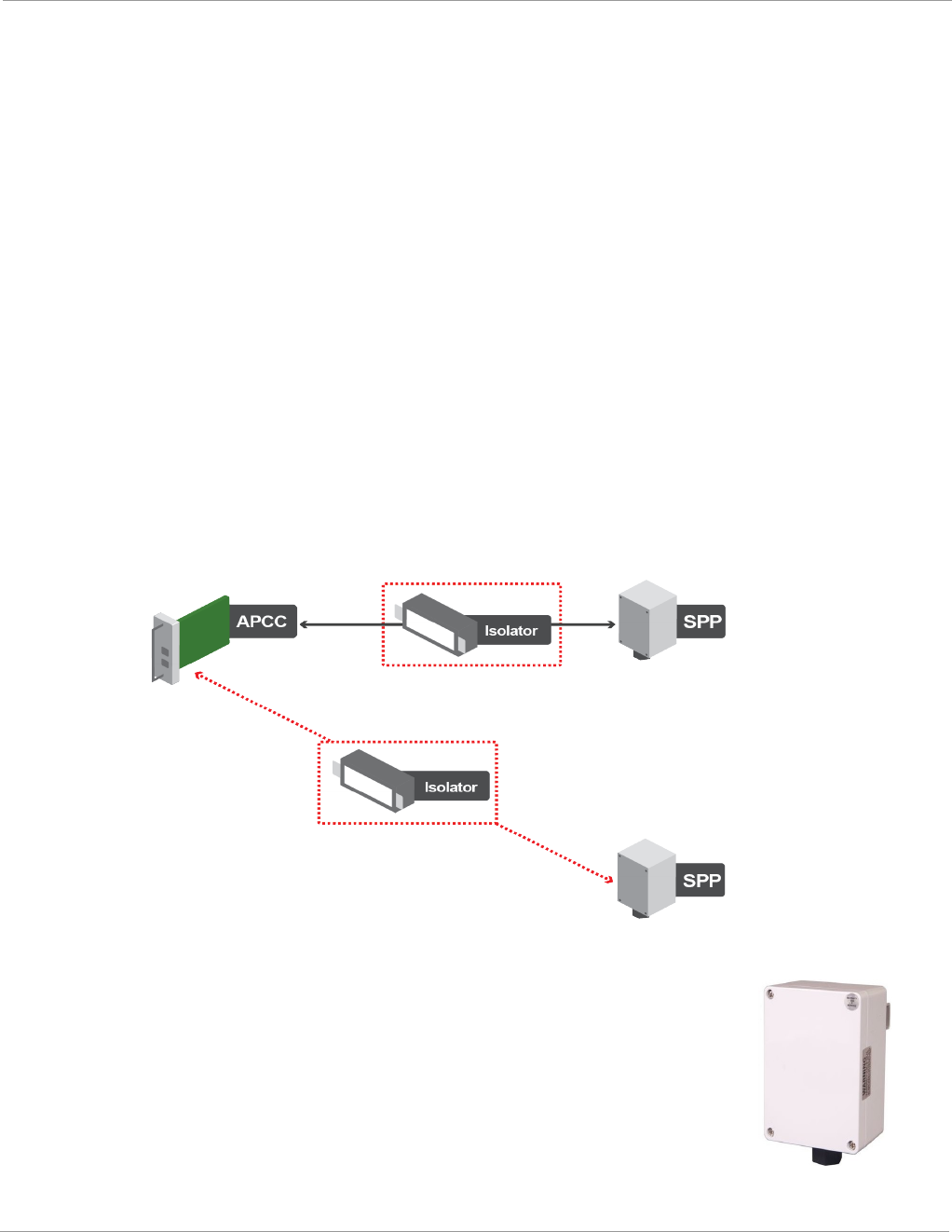
Access Point Controller Card Installation Guide Overview
Contact Closure Expansion Card
Additional capacity (to handle more sensors or controller channels) is provided by a contact closure
expansion card (EX card). EX cards use the same form factor as CC cards and are daisy-chained to
a CC card by front-panel RJ45 jacks or backplane connectors. Up to 63 EX cards can be used per
CC card.
Types of APCC Configurations
The APCC single-slot configuration consists of dual APCC radio ports, Sensys Networks Expansion
(EX) port, and contact closure interface via backplane to a traffic controller. It also has dual USB
2.0 full speed host ports and 10/100Base-T network access. The APCC dual-slot configuration adds
an SD memory card, real-time battery-backed clock, dual serial (DB9) interface, and an optional
second serial port or built in cellular modem.
APCC System
The minimum APCC system consists of an APCC and one SPP radio. The system can also consist of
multiple SPP radios and an isolator that offers electrical isolation up to 1500V, surge protection up
to 1500V, and AC power cross protection.
Figure 2-1: APPC system configuration
APCC Serial Port Protocol (SPP) Digital Radio
The APCC, along with the SPP, maintains two-way wireless links to an
installation’s sensors and repeaters, establishes overall time
synchronization, and transmits configuration commands and message
acknowledgements.
Sensys Networks, Inc. - 10 -

Access Point Controller Card Installation Guide Overview
Isolator
The isolator is an optional component that provides the
following services:
•connects an SPP to the APCC
•isolates and routes power from the controller backplane
to the SPP
•provides a wired port for IP network access (suitable for network configuration,
management and data acquisition)
APCC Package Contents
Each APCC is shipped with the items listed below. Verify that you have received all of them. In the
event that some items are missing, contact Sensys Networks or the party that supplied the
equipment to you.
The items in a Sensys Networks APCC shipment include:
•An APCC
•Access Point Controller Card Installation Guide (this document)
•Information sheet
The Sensys Networks APCC is shipped with a factory default configuration suitable for bench-
testing the device and typically require further configuration to meet the needs of specific
applications. Hardware serial numbers are found on the information sheet.
The APCC and EX cards are available in the models as shown below. Verify that you have the
correct model for your application.
Product Description
APCC-M APCC Module
APCC-MP APCC Module, Peripheral Support (I/O Board without modem)
APCC-MP-A APCC Module, Peripheral Support (I/O Board with modem)
EX-170 Expansion Card for Type 170, Type 2070 (2/0 relay), or NEMA TS1 traffic controllers
EX-TS2 Expansion Card for Type 2070 or NEMA TS2 traffic controllers
Table 1: APCC Models
SPP Package Contents
Each SPP is shipped with the items listed below. Verify that you have received all of them. In the
event that some items are missing, contact Sensys Networks or the party that supplied the
equipment to you.
Sensys Networks, Inc. - 11 -

Access Point Controller Card Installation Guide Overview
The items in an SPP shipment include:
•An SPP (either Ethernet or serial port configuration)
•“Tool less” push/pull Ethernet bulkhead connector
•Power-over-Ethernet (PoE) injector
•48V power supply
•Universal mounting kit
•Information sheet (one per device)
SPP digital radios are shipped with a factory default configuration suitable for bench-testing the
device and applicable to many field environments. The information sheet details the physical
attributes of the SPP as well as key configuration elements.
SPP information sheets contain the following elements:
•Serial number – a globally unique identifier for the SPP
•Default RF channel – a critical configuration property
•Default IP address
•Firmware release version
Note: RF channel is essential for communicating and further configuring the wireless sensor network.
Save all information sheets for the party who will configure and use the network after it is installed.
Refer to the Configuration chapter of the Sensys Networks VDS240 Wireless Vehicle Detection
System Reference Guide for more information about network operations and configuration.
Universal Mounting Kit Contents
The following parts are included in the SPP mounting kit:
•SPP ball plate (rectangular, attached to the SPP at the factory, see Figure 2.2)
•Surface mounting ball plate (square, see Figure 2.3)
Sensys Networks, Inc. - 12 -
Figure 2-2: Factory installed ball plate (rectangular)

Access Point Controller Card Installation Guide Overview
•Double socket arm (see Figure 2.4)
•5-foot clamp band
•Clamp fastener
Additional Parts and Equipment Required
Additional parts and equipment required for installation and configuration of a APCC include the
following:
•Standard Ethernet compatible, outdoor rated, 4-pair CAT5 (or better) cable (see Notes
below)
•RJ45 jack kit and crimp tool
•Cable ties
•PC or laptop with Microsoft Windows (XP, Vista, 2007) and TrafficDot, the system
management software tool from Sensys Networks.
Note: Access points are available with a range of options. Verify that the access point you
are using with the contact closure card(s) is appropriate for that use.
Sensys Networks, Inc. - 13 -
Figure 2-3: Surface (wall/beam/pole) mounting ball plate
(square)
Figure 2-4: Double socket arm

Access Point Controller Card Installation Guide Overview
Notes
1. Cabling – a minimum of two straight-through Ethernet cables are required.
2. Laptop PC and TrafficDot software – if contact closure cards will be configured
via TrafficDot's GUI, a suitable host is required.
3. APCC and EX cards may also be configured via the switches on their front panel
obviating the need for a laptop PC and TrafficDot.
Sensys Networks, Inc. - 14 -

Access Point Controller Card Installation Guide
CHAPTER 3
APCC Installation Considerations
This chapter provides the installation considerations for the APCC. Prior to installing an APCC
ensure that the following aspects have been considered in the site design.
1. Identify the devices that will be used with the APCC.
2. Determine the configuration of the APCC.
3. Determine the number of available slots in the traffic controller's detector shelf
and which contact closures are required.
4. Develop the sensor-to-contact closure card mappings.
Identifying the SPP, Access Points and Sensors
SPP
Each APCC must connect to an SPP. This connection supplies power to the an SPP and passes
command and configuration data to/from the APCC. There is a one-to-one relationship between
access points and master cards in a network.
Determine the location of the SPP relative to the cabinet that will hold the APCC card. The Cat5
cable that connects to the SPP to the APCC, via an Isolator, must meet standard length limitations
for RS422 communication .
Sensys Networks, Inc. - 15 -

Access Point Controller Card Installation Guide APCC Installation Considerations
Access Points
Each APCC must connect to an access point. This connection supplies power to the access point and
passes command and configuration data to the master card. There is a one-to-one relationship
between access points and master cards in a network.
Determine the location of the access point relative to the cabinet that will hold the APCC. The cable
that connects to the access point to the APCC must meet standard length limitations for Ethernet
over CAT5 (or better) cable. (See the Installation Procedures chapter for more information.)
Note: The APCC is are never directly connected to a access point. EX cards are daisy-chained
together with the APCC at the head-end of the chain.
Wireless Sensors
Each channel of an APCC interfaces a designated set of sensors to a designated contact closure.
Ensure information describing which sensor (or sensors) will actuate a given APCC is available.
Note: Wireless sensor have a unique identifier know as the SensorID. Use this identifier to
refer to sensors in design notes and plans.
Determining the Device Configuration
Configuration of an APCC is based on the following design decisions:
•The number of APCC channels enabled
•The operating mode (pulse or presence) of each channel
•The use of and settings for any optional elements that modify the behavior of channels
operating in presence mode
•The channel status communication method (LED-only or LED with audible tone) used by
each channel
Refer to the Sensys Networks VDS240 Wireless Vehicle System Reference Guide for more
information of the topics above.
Configuration Worksheet
Each APCC supports up to four channels that are separately configured. Design decisions can be
captured in a Channel Configuration Worksheet such as the one shown below. (Note: default
values are shown in bold.)
Sensys Networks, Inc. - 16 -

Access Point Controller Card Installation Guide APCC Installation Considerations
Channel Configuration Worksheet
Configuration Element Options Example Data
1. Card identifier
(Defined by the traffic controller or installer)
2. Channel 1, 2, 3, 4 1
3. Channel State Enabled | Disabled Enabled
4. Channel Mode Pulse | Presence Presence
4a. Presence Mode Modifier
(applicable only to channels in presence mode)
4b. Modifier Type None | Delay | Expansion Delay
4c. Modifier Duration 0 – 31 seconds in 1 sec increments (
Delay, Delay16+
)
0 – 7.5 seconds in 0.5 second increments (
Expansion
)
5
5. Channel Holdover Setting 0 - .75 seconds in .05 second increments 0
6. Channel Status Communications LED-only | LED and Tone LED
Other Information (Optional)
Access Point identifier
(from Access Point)2 SNAPS 2.4 Online Help
N/A Update Just-in-Time Help and
provide new help for new application pages. M.
Bunshaft 02-21-11 02-28-11 03-08-11 100%
Online help is complete and integrated into
the application.
192.2.68.100
Distance from Access Point 328 feet (100 meters) – 10BaseT 6 feet
List of Wireless Sensor for the Channel
(use SensorIDs of each sensor)
0707
AC15
020D
Table 2: Channel Configuration Worksheet With Example Data (Default values shown in bold)
Notes
1. Contact closure cards are addressed by the Card ID, a value dictated by the
controller or supplied by the installer.
2. Complete one worksheet for each channel.
3. Channel Holdover Setting should not be used; set it to zero.
4. The items listed in the section Other Information are not part of APCC
configuration. They are relevant to other aspects of installing and operating the
APCC.
Sensys Networks, Inc. - 17 -

Access Point Controller Card Installation Guide APCC Installation Considerations
Determining Slots and Contact Closures
Configuration of contact closure cards depends on (i) the availability of open slots on the controller
backplane and (ii) the use of any predefined functions or phases for each slot – such as in the case
of a standard CalTrans 322 shelf, where one contact closure card and three contact closure EX
cards are required (one card per phase). Typically, a site survey of the traffic controller is required.
Shelf and slot information from the controller are used to create an identifier, known as the Card
ID, that uniquely defines an APCC in the network. (See the Installation Procedures chapter for
more information on setting the Card ID.)
Mapping Wireless Sensors to Contact Closures
The final installation consideration for for contact closure cards are the assignment of sensors to
specific channels.
The four channels represent independent contact closures which, in turn, are actuated by the
vehicle detection events transmitted by a defined group of wireless sensors. Each sensor may be
associated with zero or one Card ID / Channel combinations.
Up to 15 wireless sensors can be associated with the same card/channel, in which case the sensors
are logically “OR-ed” together – meaning that if any sensor on the channel detects a vehicle, the
corresponding contact closes.
The sensor-to-contact closure channel mappings are stored in a sensor database that resides in
memory. The sensor-to-contact closure channel mappings are maintained with TrafficDot, the
Sensys Networks system management application.
Defining the channel mappings is aided by the use of a Channel Mapping Worksheet such as the
one shown below.
Sensor-to-Channel Mapping Worksheet
Card ID Channel (1 - 4) Sensor ID Channel Extension (opt.) Location / Lane / Description (opt.)
3-02 1 06C2 0 East bound, lane 1
3-02 1 06C3 0 East bound, lane 2
3-05 2 14C7 0 Advance C.3
3-06 3 0404 0 Stop bar A1
3-15 1 05D7 0 West bound, lane 1
Table 3: Sensor-to-Channel Mapping Worksheet With Sample Data
Sensys Networks, Inc. - 18 -

Access Point Controller Card Installation Guide APCC Installation Considerations
Notes
1. The worksheet assumes one sensor per row. Use as many rows as necessary to
assign all necessary sensors to channels.
2. Do not duplicate Sensor ID values. (A wireless sensor may only be assigned
once.)
3. The sample data above depicts representative Card ID values. Since these values
are rarely known prior to field installation, substitute a place-holder value so
that the installer will understand how the wireless sensors are allocated to the
channels.
4. Values for Channel Extension and Location are optional.
Sensys Networks, Inc. - 19 -

Access Point Controller Card Installation Guide
Chapter 4
SPP Installation Considerations
This chapter provides the installation considerations for the SPP. Prior to installing the SPP, ensure
that the following aspects have been considered in the site design.
•Powering the SPP
•Collecting Data From the
•Determining the Location of the SPP
Each consideration is discussed below. In addition, refer to the Sensys Wireless Vehicle Detection
System Reference Guide, Design Guidelines for Freeway Applications, and Design Guidelines for
Intersection Applications for more information.
Powering the SPP
The overall network design determines how the access point is powered; two general models are
supported:
•Acquiring power directly from a traffic controller cabinet
•Acquiring power from a traffic controller using optional isolator
Acquiring Power From a Traffic Controller
An SPP can be directly interfaced to a traffic signal controller through an APCC. When this is the
case, power to the SPP is drawn from the traffic controller as shown in the following figure.
Sensys Networks, Inc. - 20 -
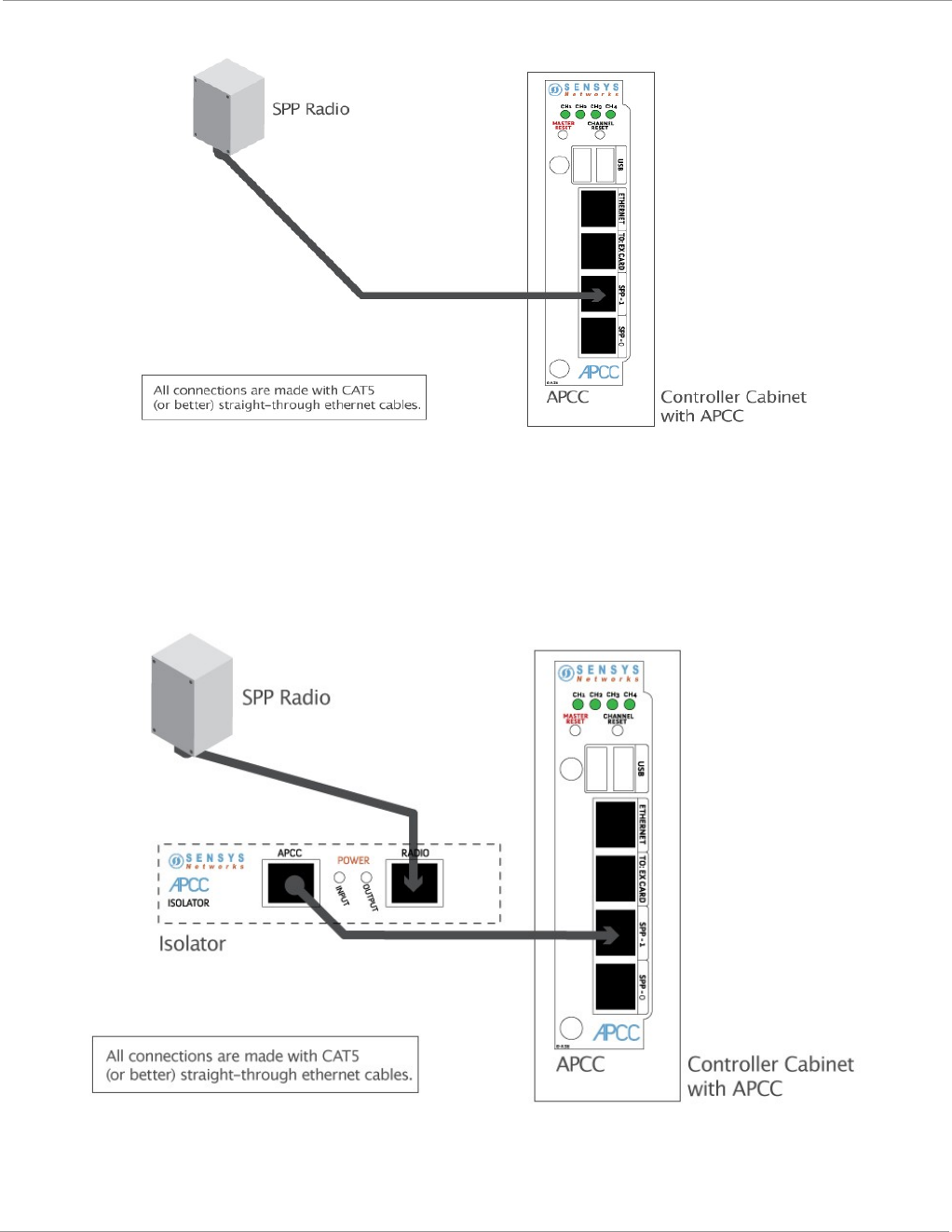
Access Point Controller Card Installation Guide SPP Installation Considerations
Figure 3.1 – SPP radio powered from a traffic controller
Acquiring Power Form Traffic Controller Using an Isolator
An optional isolator can be used when acquiring power from the traffic controller as shown in
following figure.
Figure 3.2 – SPP radio powered from a traffic controller
Sensys Networks, Inc. - 21 -

Access Point Controller Card Installation Guide SPP Installation Considerations
Voltages
Access points use the following voltages drawn from one of the following sources:
•36VDC – 58VDC (48VDC nominal) - typically supplied from a nearby traffic controller
cabinet or power pole
•10VDC – 20 VDC (12 VDC nominal) - typically supplied from a solar panel
Cabling
Standard Ethernet compatible, outdoor rated, 4-pair CAT5 or better cable is required. The
maximum cable length is 100 meters (328 feet). The cable should be terminated with RJ45
connectors according to the TIA/EIA 568-B specification when it is installed.
Note: The outside diameter of the cable is an important attribute. The cable's OD is used to select the
proper bushing for the access point's bulk head connector on access points manufactured after May
2010.
Collecting Data From the APCC
The APCC automatically collect detection events and, depending on the network design, forward
them to upstream traffic information systems and management servers via an IP network
connection. An on-board Ethernet network interface facilitates this. In situations where a wired
network connection is not available, a modem supporting either GSM-based or CDMA-based
cellular services may be added.
The following connection models are supported for IP communications:
•Connection via a wired network path – for example, bench configuration prior to
installation, field access based on patching a technician's laptop to the access point via an
Ethernet cable, or an available wide area network connection.
•Connection via a wireless network path – for example, using GSM cellular networks
(EDGE/GPRS data services) or CDMA cellular networks (1xRTT data services).
Additionally, event data may be forwarded to a local traffic signal controller via an APCC. This
interface converts event data to the signal pattern required by the traffic controller.
Determining the Location of the SPP
The physical location of the SPP is the primary determinant of communications quality and, as
such, the network's overall usefulness and reliability. Selecting a location involves several factors
(including other local RF transmissions) that may make pre-assigned locations problematic.
Sensys Networks, Inc. - 22 -

Access Point Controller Card Installation Guide SPP Installation Considerations
Optimal Location Criteria
Optimal locations for SPP digital radios meet all of the following criteria:
•are high enough to promote high quality RF communications on a sustained basis
•allow a line-of-sight path to the APCC, (optional) isolator, and wireless sensors
•are within recommended distances for the APCC, (optional) isolator, and wireless sensors
•allow the SPP to be mounted with its bulkhead connector and cellular antenna (if
applicable) pointed toward the ground
•allow the SPP to face the APCC, (optional) isolator, and wireless sensors
•are within specified cable length limits
•do not submit the SPP to avoidable vibration, shaking or movement
•are reasonably accessible to field support personnel
Sensys Networks, Inc. - 23 -

Access Point Controller Card Installation Guide SPP Installation Considerations
CHAPTER 5
APCC Installation Procedures
This chapter provides the instructions for installing and cabling an APCC.
Overview
Installation and setup of APCC occurs at the site of the traffic controller and consists of the
following activities:
•Determining the Card ID and setting it via circuit-board dip switches SW1 and SW2
•Determining the controller type and setting it via circuit-board dip switch SW1
•Connecting cables to each device
Determining the Card ID and Setting it via Circuit-board Dip
Switches SW1 and SW2
APCC and EX cards are addressed via a value known as the Card ID. A Card ID must be unique to
the network and is required for communication between the APCC and the EX cards.
Card ID values are expressed as: [ shelf number ] ― [ slot number ].
Both shelf-number and slot-number must be determined to create a Card ID.
Some traffic controllers designate the card address, while others (typically older models) do not. In
the latter case, the installer assigns the Card ID ensuring that it is unique to the network.
Follow the procedures in this section for each contact closure card to be installed.
Sensys Networks, Inc. - 24 -

Access Point Controller Card Installation Guide APCC Installation Procedures
Factory Default Card ID
Card IDs are implemented on Sensys Networks contact closure cards via two dip switches found on
the side of the card. In this guide, the switches – named SW1 and SW2 respectively – are referred
as circuit-board dip switches to differentiate them from other dip switches on the front-panel of
contact closure cards.
A default Card ID of “03-15” is assigned at the factory and is shown in the figure below. (Note that
on the card, switches SW1 and SW2 are not as close to one another as shown in the figure.)
Figure 5.1 – Default Card ID (all dips down)
Before proceeding, ensure that switches SW1 and SW2 are set as in the figure above and,
additionally, that all front-panel switches are in the right-hand position.
Querying the Backplane for an Assigned Address
The APCC support an operating mode (called X mode) that queries the traffic controller backplane
for an address. Because it can be difficult to determine from visual inspection if the backplane
dictates card addresses, the standard practice is to use X mode to see if this is the case.
X mode uses the four front-panel channel LEDs to visually indicate the backplane address assigned
by the controller (if any). (Refer to Appendix 1 for a figure that depicts how the channel LEDs are
used.)
Follow these steps to use X mode to query the controller for a card address:
1. Verify that the APCC is set to its default Card ID and that all front-panel
switches are in the right-hand position.
2. Reset the APCC by pressing the master reset button (located on front-panel next
to channel LEDs) or removing the unit from the cabinet and re-inserting it.
3. Observe the front-panel channel LEDs. Match the pattern of lighted LEDs with
the figure in Appendix 1.
The address value that matches the LED display pattern (from Appendix 1) is the slot
number component of the Card ID.
Note: After the cabinet backplane is queried for an address, be sure to take the APCC card out
of X-mode by setting front-panel dip switch 2 to the right, and resetting the card.
Sensys Networks, Inc. - 25 -

Access Point Controller Card Installation Guide APCC Installation Procedures
Setting the Slot-Number With Circuit-board Dip Switch SW2
Circuit-board dip switch SW2 implements the slot number component of the Card ID. Set switch
SW2 to match the value derived from the figure in Appendix 1 subject to the exception noted below.
Exception
In cases where the controller does not assign an address, the installer will see a front-panel
channel LED display pattern indicating an address of 15 (all LEDs lighted). This address can be
used for the first contact closure card installed. However, subsequent cards must be given a
different address ― arbitrarily assigned by the installer. Any value between 0 and 15 may be
used; remember that Card IDs must be unique for the network.
Refer to Appendix 3 for a figure that illustrates how to set switch SW2 to values between 0 and 15.
Setting the Shelf-Number With Circuit-board Dip Switch SW1
Circuit-board dip switch SW1 implements the shelf number component of the Card ID. Shelf
numbers are assigned by the installer after visually inspecting the cabinet.
The convention is to consider the top-most shelf in the card rack as shelf zero and to increment the
shelf number by one for each shelf below the top-most shelf. For example, the bottom shelf in a
cabinet of four shelves would be considered shelf three.
Set circuit-board dip switch SW1 to the shelf number using the two left-most switches. Refer to
Appendix 2 for a figure that illustrates how to set switch SW1 to values between 0 and 3.
Determining the Controller Type and Setting it via Circuit-
board Dip Switch SW1
At the factory, contact closure cards are set for use with Type 170, Type 2070 (without status
relays), or NEMA TS1 traffic controllers. This setting is made with switch three of circuit-board dip
switch SW1.
Verify the controller type and set dip three of circuit-board dip switch SW1 as needed. Use the
figure in Appendix 2 as a guide for setting switch 3 of SW1 to the proper value.
Connecting the Cables to Each Device
Cable the devices according to the steps below. See also the section Cabling Summary below for
figures that depict the supported cabling schemes.
Note: The steps below are for a system configuration that contains an optional isolator, and an EX
card. A figure of a minimal cabling configuration is shown in the Cabling Summary section.
1. Connect a straight-through CAT5 (or better) cable, terminated with RJ45
connectors to the SPP and the port labeled “Radio” on the isolator.
Sensys Networks, Inc. - 26 -
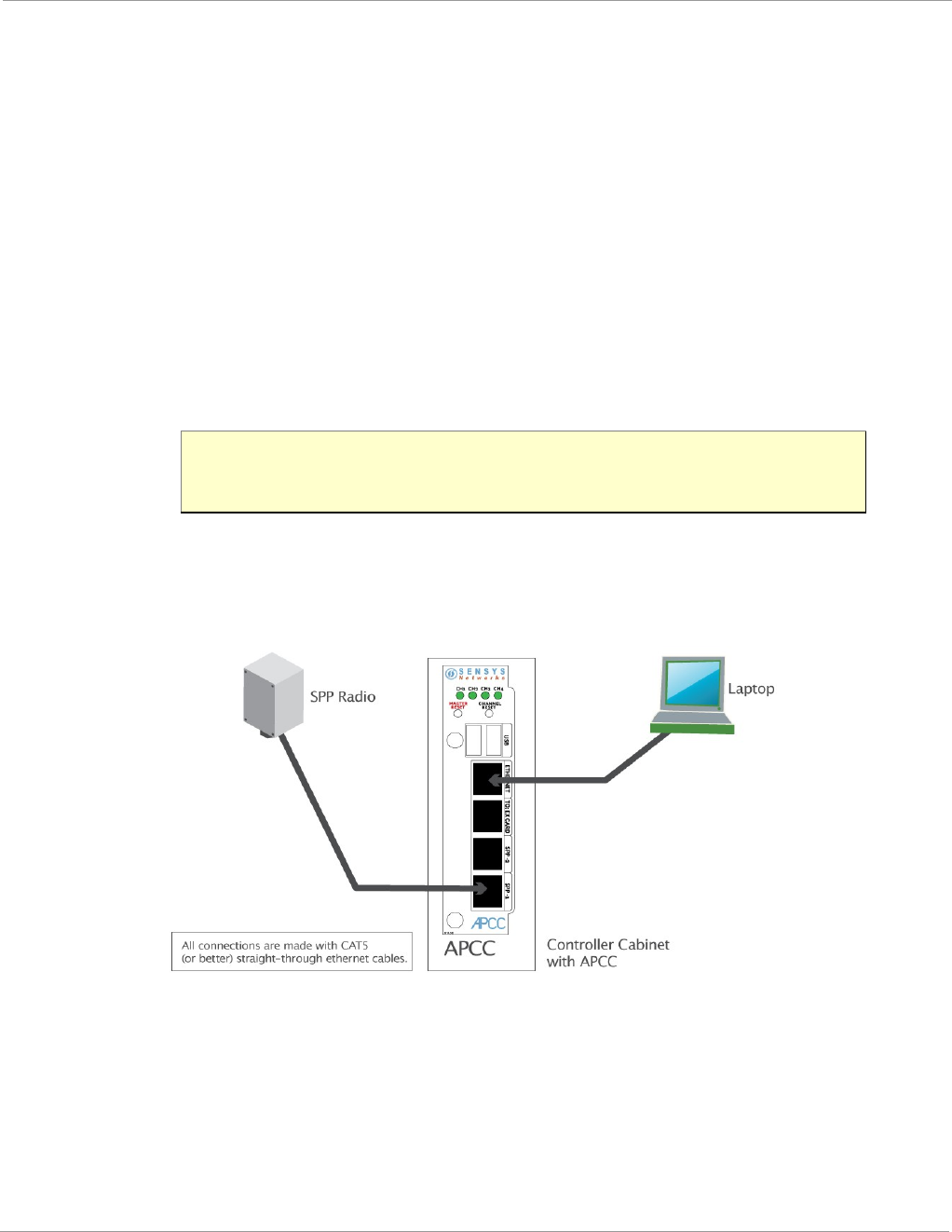
Access Point Controller Card Installation Guide APCC Installation Procedures
2. Connect a straight-through CAT5 (or better) cable, terminated with RJ45
connectors to the jack labeled “APCC” on the isolator and the port labeled “SPP-1
or SPP-0” on the APCC.
The green LED labeled “Power” on the APCC should light.
3. Connect a straight-through CAT5 (or better) cable, terminated with RJ45
connectors to the jack labeled “TO: EX CARD” on the APCC and the port labeled
“IN” on the EX card.
4. To connect a laptop PC to the system, connect a straight-through CAT5 (or
better) cable, terminated with RJ45 connectors from the laptop to the port
labeled “ETHERNET” on the APCC.
5. To connect the APCC to a hub, bridge, switch, router or similar device, use a
cross over Ethernet cable.
Note: Steps 4 and 5 are optional. Connect the laptop PC to the APCC to configure or
manage the contact closure cards through TrafficDot, the system management tool from
Sensys Networks.
Cabling Summary
The cabling to connect an APCC, SPP and laptop is shown in the following figure.
Figure 5.3 – Cabling a PC or Laptop
The cabling to connect an APCC, SPP, isolator, hub or switch, and laptop PC is shown in the
following figure.
Sensys Networks, Inc. - 27 -
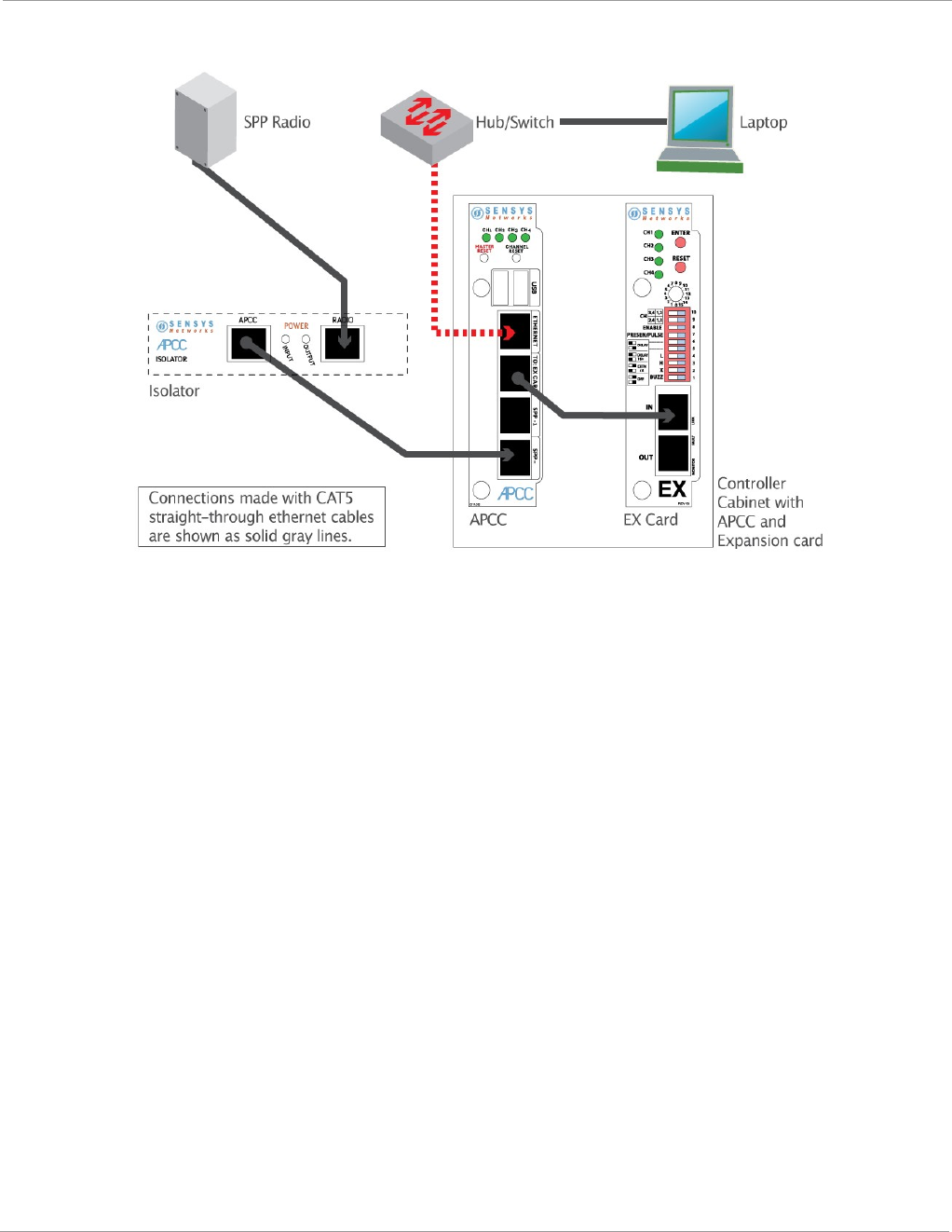
Access Point Controller Card Installation Guide APCC Installation Procedures
Figure 5.4 – Cabling an isolator and hub or switch to an APCC
Sensys Networks, Inc. - 28 -

Access Point Controller Card Installation Guide
CHAPTER 6
SPP Installation Procedures
This chapter provides the instructions for installing and mounting an SPP.
Installing an SPP consists of the following:
•Attaching the square surface mounting ball plate to an available vertical surface
•Attaching the SPP to the surface mounting ball plate via the double socket arm
Mounting hardware is included in the universal mounting kit provided with each SPP.
Tools Required for SPP Installation
The following tools are required for installing an SPP:
•RJ45 crimp tool – to terminate the SPP cable. (Sensys Networks recommends the EZ-
RJPRO P/N 100044 from Platinum Tools.)
•RJ45 connectors – rated Cat5e or better; to terminate the SPP cable
•Cat5e cable continuity line tester – to validate cable continuity
•Outdoor rated Cat5e Ethernet cable – to build the SPP cable; length is determined by the
distance between the SPP mounting location and the source of power (typically a controller
cabinet, solar panel or other available source)
•2 straight-through Cat5 Ethernet cables – each approximately three feet in length; used in
installations where the SPP is connected to a contact closure card in a controller cabinet.
•The cables connect the AccessBox to (i) field engineer's laptop (for SPP configuration) and
Sensys Networks, Inc. - 29 -

Access Point Controller Card Installation Guide SPP Installation Procedures
(ii) to the contact closure card in the cabinet.
•Additional straight-through Cat5 Ethernet cables – optional; each approximately one foot
in length; these cables are used to daisy chain multiple contact closure cards. Required only
in the case of multiple CC/EX cards.
•1 cross-over Cat5 Ethernet cable – optional; approximately three feet in length; used to
connect an AccessBox to an Ethernet switch/hub that is local to the controller cabinet.
Required only when a connection to a local hub/switch is specified.
•Lift truck – to install the SPP 16 – 30 feet above the road surface
•Screwdriver – combination flat and Phillips head ends
•Universal mounting kit – double-socket arm holds the SPP. (Kit supplied by Sensys
Networks.)
•Clamp band kit – for attaching double-socket arm to mounting pole. (Kit supplied by
Sensys Networks.)
•Pliers – used to work the clamp band
•Wire cutters – used to cut the clamp band
•Double-sided sticky tape – attaches AccessBox to flat surface inside the controller cabinet
Step-by-Step Procedures
The square surface mounting ball plate can be installed on any available vertical surface sufficient
to support the SPP including poles, walls or beams. This section provides procedures for pole
installation; considerations for wall or beam mounting follow this section.
Installing the Mounting Plate on Poles
When attaching the square surface mounting ball plate to a pole, the clamp band is used to secure
the ball plate to the pole. (See Appendix 1 for more information about working with the clamp
band.)
Follow these steps to perform the installation:
1. Use the measuring tape to determine the circumference of the pole that will hold the
ball plate.
2. Subtract four inches from the measured circumference and cut the band to that
length. Cut the band through the center of the nearest round hole.
3. Feed the clamp band through the square ball plate using the custom clamp holes (see
figures below) until the square ball plate is at the center of the band. Attach the
fastener to one end of the band by diagonally inserting the end.
Sensys Networks, Inc. - 30 -
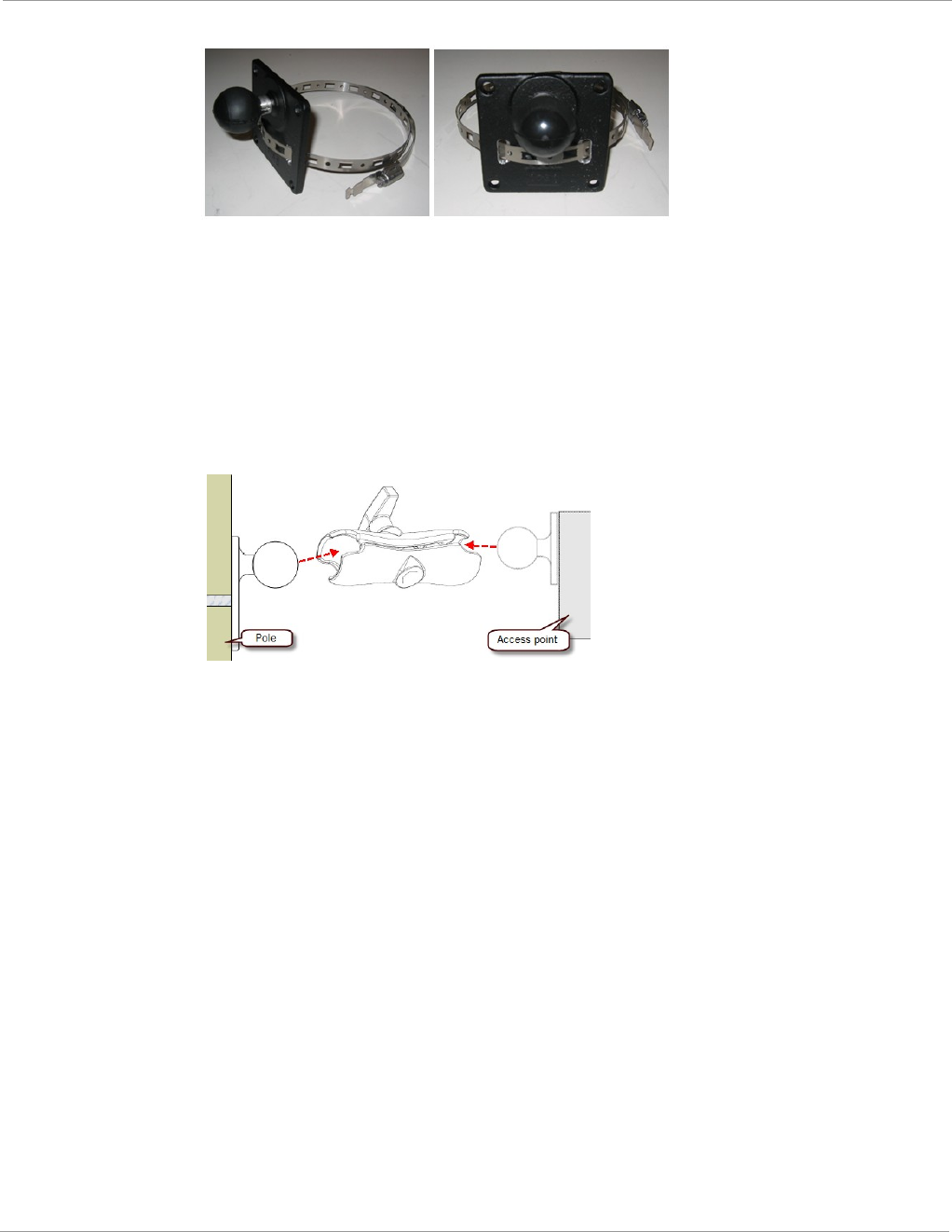
Access Point Controller Card Installation Guide SPP Installation Procedures
4. Use the cloth to clean the area of the pole that will meet the ball plate. Remove the
double stick tape cover from the back of the plate, wrap the clamp band around the
pole, and attach the second (non-engaged) end of the fastener. Tighten the clamp to
secure it.
5. Attach the double socket arm to the square ball plate.
6. Attach the SPP ball plate to the other end of the double socket arm.
7. Point the front of the SPP toward the wireless sensors and tighten the double
socket arm to secure the SPP digital radio's position.
Installing the Mounting Plate on Walls
When attaching the square surface-mounting ball plate to a flat surface, the clamp band is not used.
Instead, attach the ball plate to the surface with screws using each of the four corner holes.
Installing the Mounting Plate on Beams
When attaching the square surface-mounting ball plate to a beam, the clamp band is not used.
Instead, attach the ball plate to the beam with beam clamps using two of the four corner holes.
Beam clamps are available from Sensys Networks.
Sensys Networks, Inc. - 31 -
Figure 6-1: Clamp band threading through surface mounting ball plate
Figure 6-2: Double socket arm installation

Access Point Controller Card Installation Guide
CHAPTER 7
Configuration
This chapter explains how to configure channels and and other operating elements of contact
closure cards in the APCC and EX cards.
Note: Prior to configuring channels, ensure that each contact closure card has been given a unique
Card ID. Refer to the Determining the Card ID section in the Installation Considerations chapter
for more information.
Overview
Each channel of an APCC or EX card is configured separately. Configuring a channel consists of the
following activities:
•Enabling (or disabling) the channel
•Specifying the channel mode
•Setting a presence mode modifier (optional)
•Specifying the type of communication used to disclose channel status
Additionally, after channel configuration is completed, TrafficDot is used to define the sensor-to-
channel mappings stored on the APCC.
After all configuration work is complete, including definition of sensor-to-channel mapping entries
for all channels, Sensys Networks recommends verifying the operation of each channel using the
front-panel channel LEDs.
Sensys Networks, Inc. - 32 -

Access Point Controller Card Installation Guide Configuration
Configuration Methods
Configuration occurs through two mutually exclusive choices: (i) the card's front-panel interface or
(ii) with TrafficDot, the system management application from Sensys Networks. This chapter
includes the following sections:
•Configuring channels with the front-panel interface
•Starting TrafficDot and Connecting to an APCC
•Configuring channels with TrafficDot
•Defining the sensor-to-channel mappings
•Exiting TrafficDot
Configuring Channels With the Front-Panel Interface
After completing the configuration of all channels, continue setting up the APCC by starting the
TrafficDot software utility and defining the sensor-to-channel mappings.
Note: If the APCC is configured with TrafficDot, this section can be ignored.
General Procedure
The general procedure for configuring channels via the front-panel is provided below. Examples of
specific configuration activities are included in the following sections. The steps are as follows:
1. Select a channel.
2. Move dip switches (as required) to represent the desired settings.
3. Press the MASTER RESET button on the card front-panel and hold it down for a
minimum of five seconds.
Sensys Networks, Inc. - 33 -
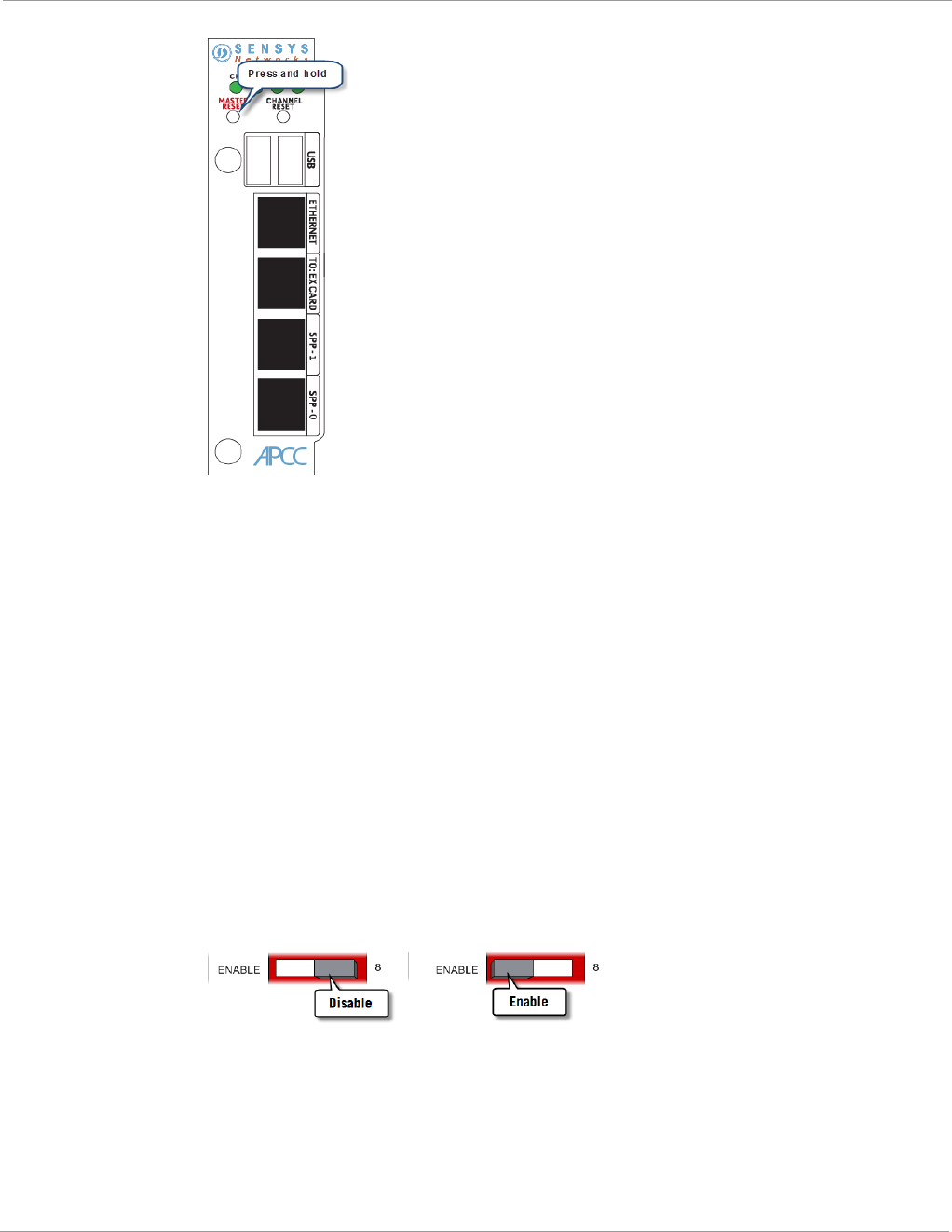
Access Point Controller Card Installation Guide Configuration
Figure 7.1 – Configuration via the front-panel interface
Saving the Configuration
After the MASTER RESET button is pressed, the LINK LED flashes. When the flashing stops,
the settings have been stored in flash memory.
The sections below give examples of setting specific configurations via the front-panel interface.
The procedures may be performed in any order or combination.
Enabling / Disabling a Channel
APCC and EX cards ship with channels one and two enabled. Sensys Networks recommends
explicitly disabling all unused channels.
Follow these steps to enable or disable a channel.
1. Position front-panel dip switch 8 to the left to enable (to the right to disable) the
channel.
Figure 7.2 – Enabling (Disabling) a channel with front-panel dip switch 8
2. Press the Enter button for five seconds to save the configuration to flash
memory or continue with other configuration activities described in this section.
Sensys Networks, Inc. - 34 -

Access Point Controller Card Installation Guide Configuration
Specifying the Channel Mode
Contact closure cards operate in either pulse or presence mode. (Refer to the Sensys Networks
VDS240 Wireless Vehicle Detection System Reference Guide for information about the operating
modes.)
Follow these steps to specify the operating mode of the channel.
1. Position front-panel dip switch 7 to the left to select presence mode or to the
right to select pulse mode.
Figure 7.3 – Selecting the channel operating mode with front-panel switch 7
2. Press the Enter button for five seconds to save the configuration to flash
memory or continue with other configuration activities described in this section.
Setting a Presence Mode Modifier (Optional)
Channels operating in presence mode may use a modifier to delay the onset of or extend the
duration of a contact closure. The modifier type and scope is specified using front-panel dip
switches five and six together. (Refer to the Sensys Networks VDS240 Wireless Vehicle Detection
System Reference Guide for more information.)
Using Delay and Extension
When Delay or Extension are specified, the rotary dial is used to articulate the numeric value
associated with the parameter.
When Delay is specified, the value set on the rotary dial is taken directly. This allows the 16-
step rotary switch to represent values from 0 to 15.
When Delay+16 is specified, the value set on the rotary dial is incremented by 16. This allows
the 16-step rotary switch to represent values from 16 to 31.
When Extension (EXTN / 2) is specified, the value set on the rotary dial is divided by 2. This
allows the 16-step rotary switch to represent values from 0 to 7.5 in ½ step increments.
Specify a contact closure delay or extension for channels operating in presence mode by following
these steps:
1. Position front-panel dip switches 5 and 6 and the front-panel rotary switch to
reflect the desired modifier and scope value. Use the figure below as a guide.
Sensys Networks, Inc. - 35 -
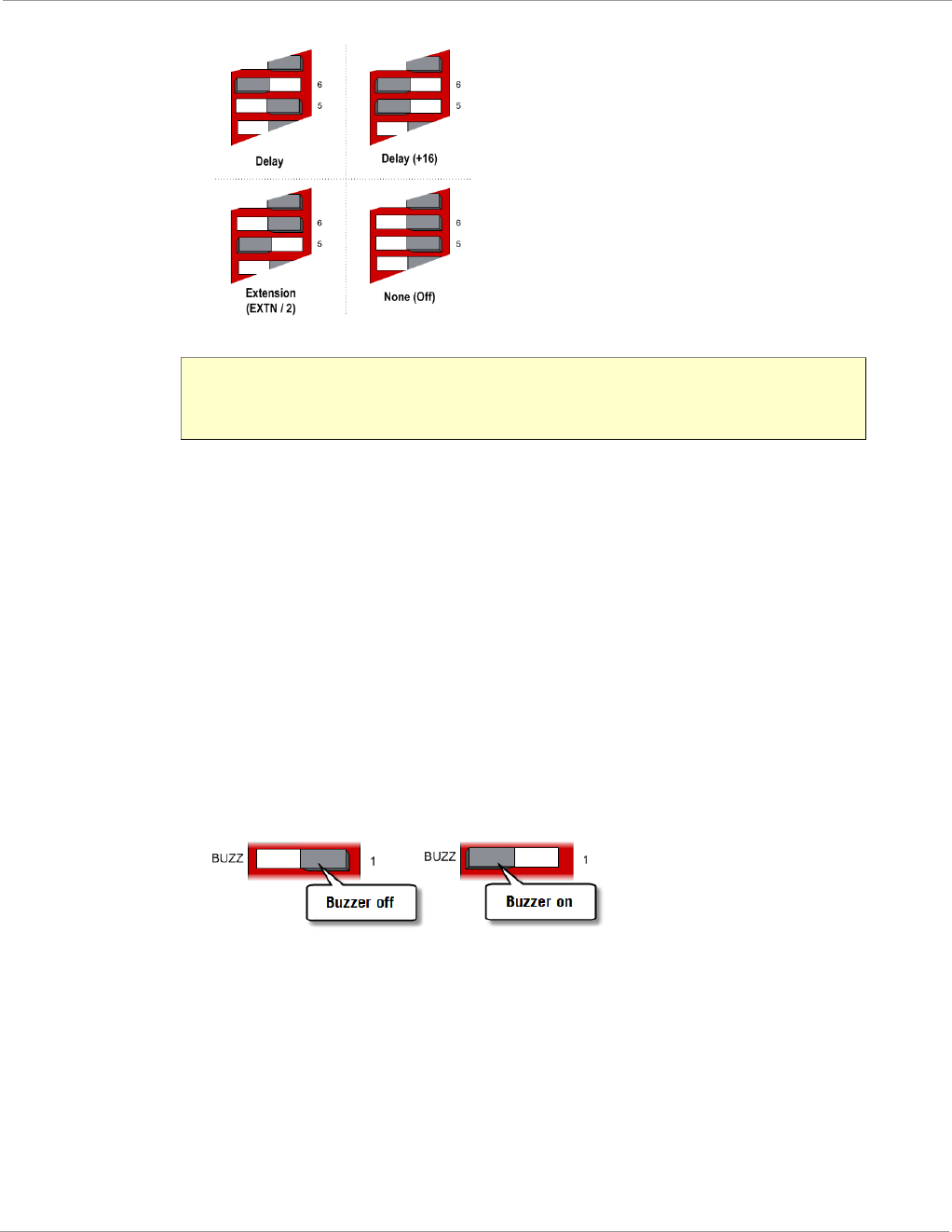
Access Point Controller Card Installation Guide Configuration
Figure 7.4 – Setting a delay or extension with front-panel dip switches 5 and 6 (Rotary switch not shown)
Note: This step is optional; set both dips to right-hand position to disable the feature.
Additionally, front-panel switches 5 and 6 are ignored for channels operating in pulse
mode.
2. Press the Enter button for five seconds to save the configuration to flash
memory or continue with other configuration activities described in this section.
Specifying the Type of Communication Used by the Channel Status Monitor
Contact closure cards indicate the status of each channel via the front-panel LEDs. The state of an
LED corresponds directly to the channel state. When the LED is on, the channel relay is closed
indicating a call. When the LED is not on, the channel relay is open.
Additionally, a contact closure card can be set such that closed channel relays activate an audible
tone (buzzer) as well as the front-panel LED for the channel. The audible channel status tone is set
via front-panel dip switch one as follows:
1. Position front-panel dip switch 1 to enable or disable the audible channel status
monitor. Use the figure below as a guide.
Figure 7.5 – Setting the channel monitor buzzer with front-panel dip switch 1
2. Press the Enter button for five seconds to save the configuration to flash
memory or continue with other configuration activities described in this section.
Sensys Networks, Inc. - 36 -
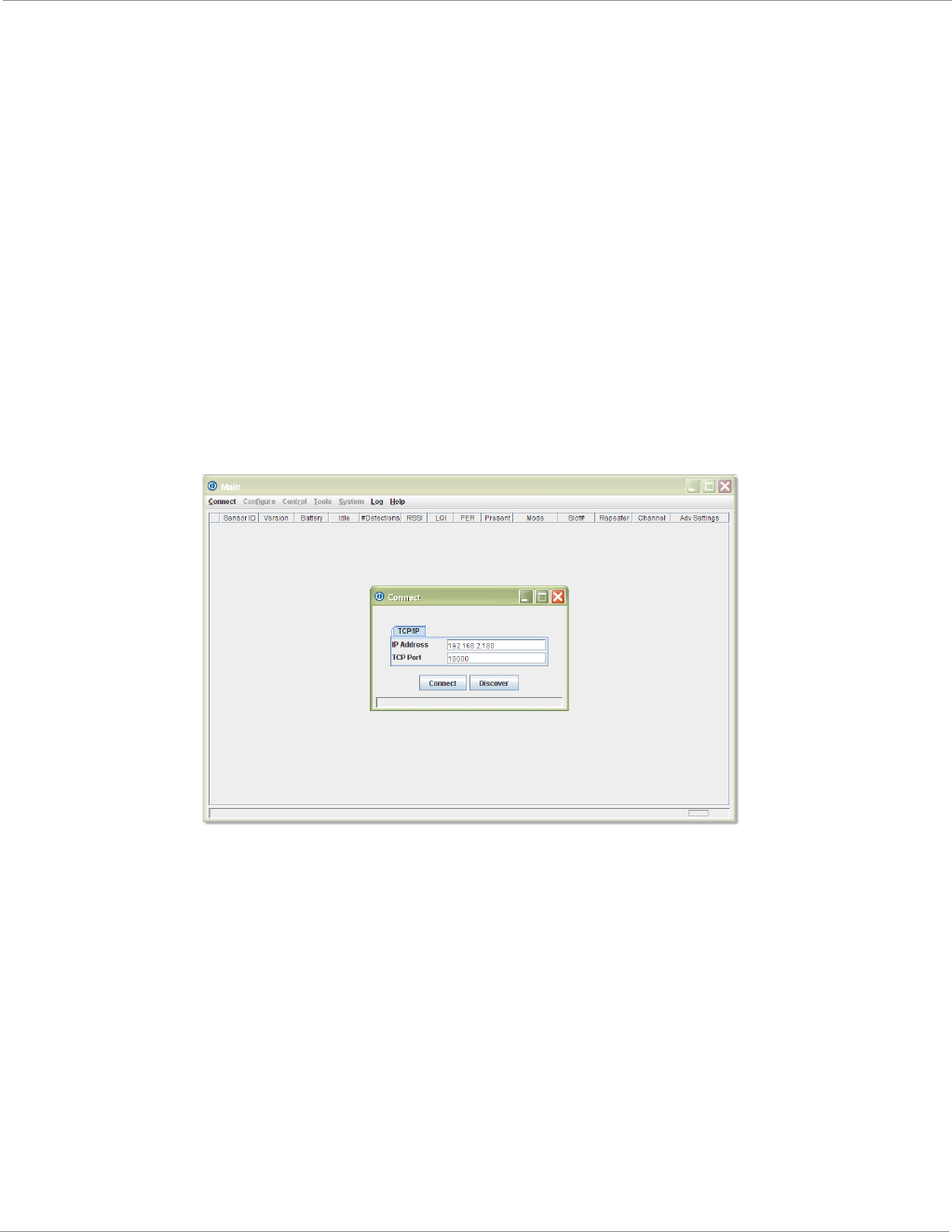
Access Point Controller Card Installation Guide Configuration
Starting TrafficDot and Connecting to an APCC
TrafficDot is a small, self-installing program that provides a graphical user interface (GUI) to the
components of a Sensys Networks Wireless Vehicle Detection network. It is used to optionally
configure contact closure cards and to define the sensor-to-channel mappings.
TrafficDot requires an IP network connection to the access point. Typically, when configuring
contact closure cards, this connection is made by cabling a laptop to the “ACCESS” port of the
AccessBox. (See the section Cabling Summary for additional information.)
See also the Sensys Networks VDS240 Wireless Vehicle Detection System Reference Guide for a
more discussion of using TrafficDot with the Sensys Networks Wireless Vehicle Detection System.
Connect to the access point with TrafficDot by following these steps:
1. On a Windows laptop or PC, start TrafficDot by clicking its icon.
TrafficDot's Main window opens with the Connect window open in front of it.
Figure 7.6 – TrafficDot Main and Connect windows
2. Type the IP address of the access point into the IP Address field and accept the
default value in the TCP Port field. Click Connect.
If you do not know the address, click the Discover button.
Discovering Access Points
The Discover button queries the local network and opens a window that lists all access
points on the network.
Sensys Networks, Inc. - 37 -
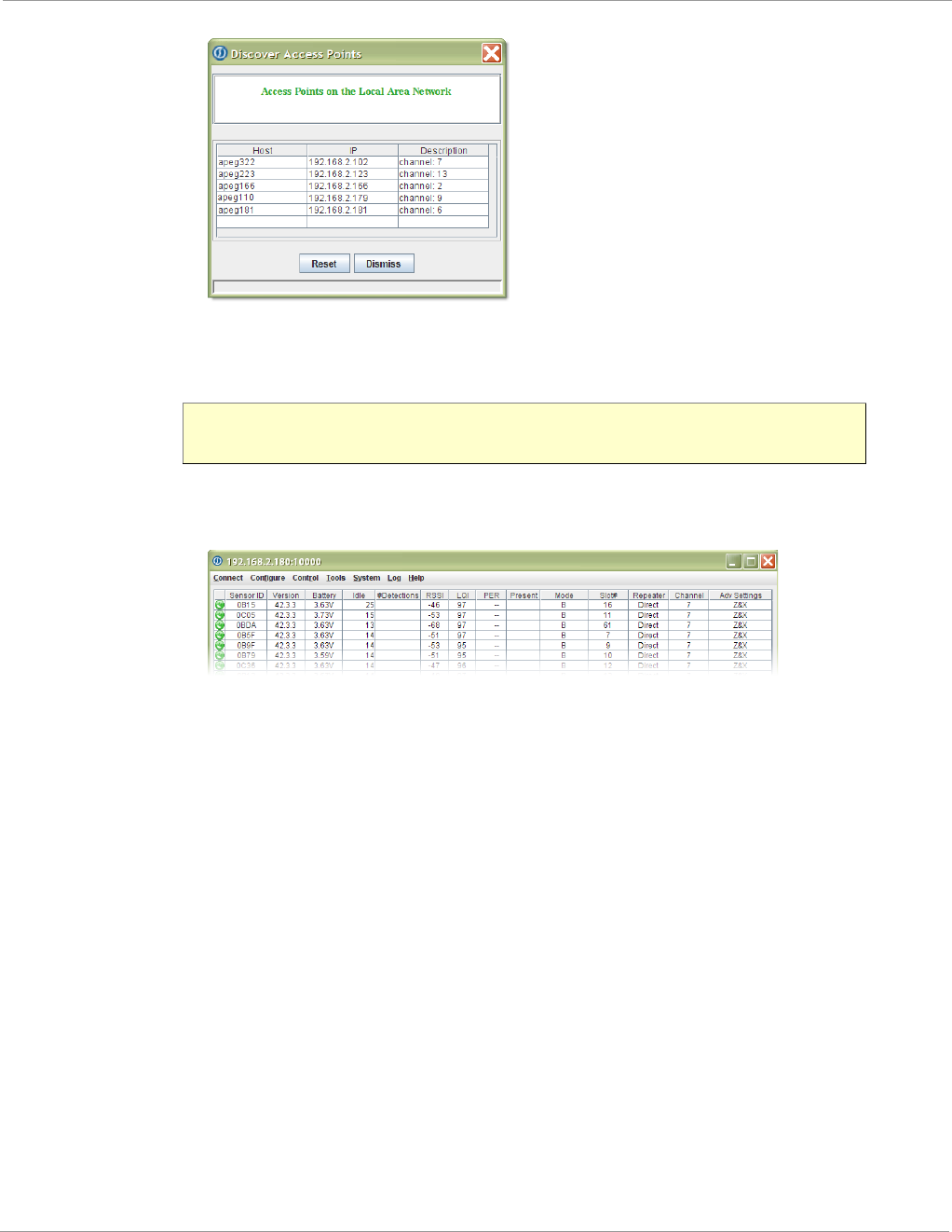
Access Point Controller Card Installation Guide Configuration
Figure 7.7 – Discover Access Points window
Make a note of the IP address of the access point you wish to connect to. Click Dismiss to
close the window and return to the Connect window at Step 2.
Note: It is not uncommon to see only one access point on the Discover Access Points
window.
3. After clicking Connect, wait a moment for the Main window to populate with
information about the network.
Figure 7.8 – Main window
Configuring Channels With TrafficDot
The general procedure for configuring APCC channels with TrafficDot is the same as for
configuring other devices from Sensys Networks. (Refer to the Sensys Networks VDS240 Wireless
Vehicle Detection System Reference Guide for information about configuring other devices from
Sensys Networks)
Configuring devices with TrafficDot consists of the following activities:
•Opening the configuration windows
•Specifying the elements of the configuration
•Saving the configuration
Sensys Networks, Inc. - 38 -
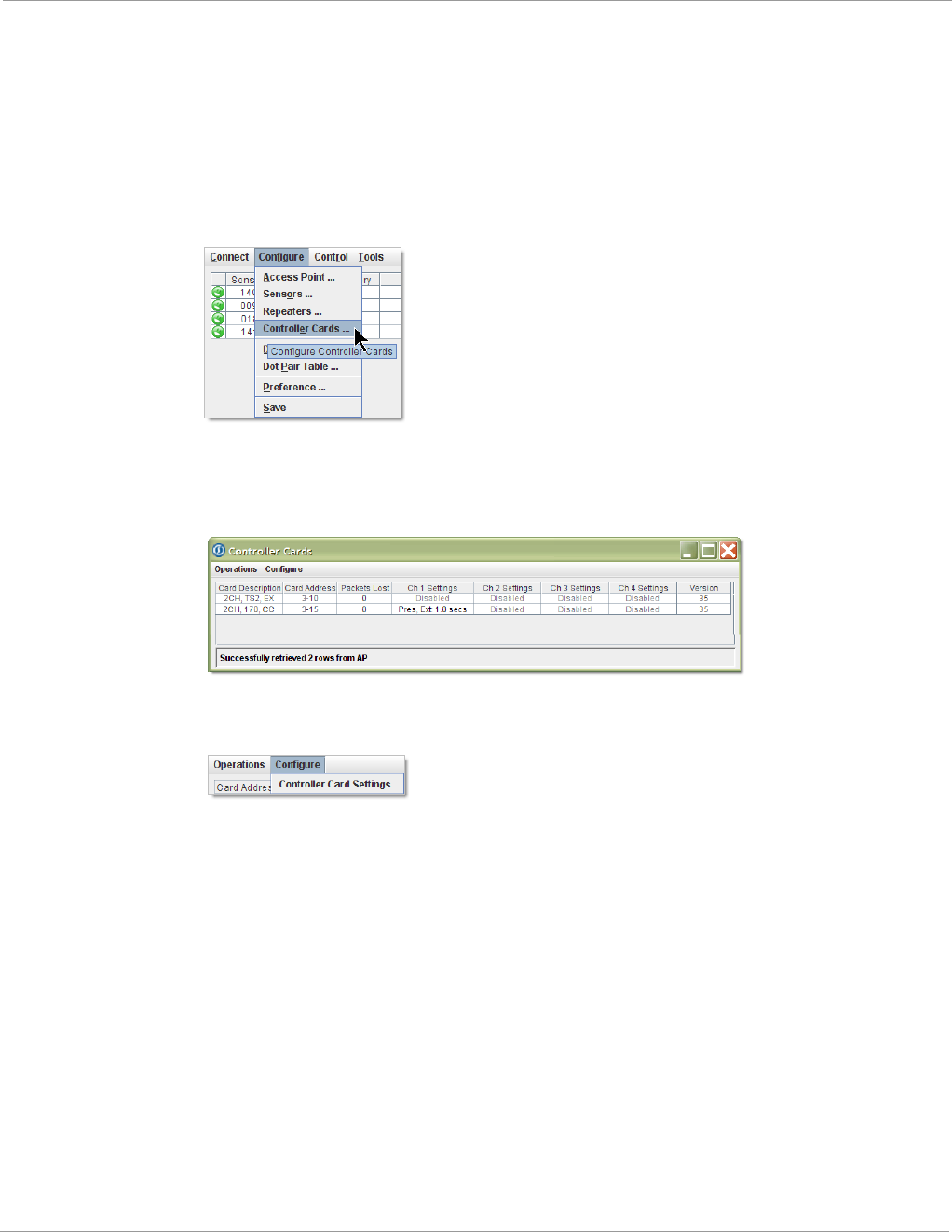
Access Point Controller Card Installation Guide Configuration
Opening the Configuration Windows for Controller Cards
Configuration of contact closure cards is accomplished with the Controller Card Configuration
window. Follow these steps to open it:
1. From the command menu on TrafficDot's main window, access the Configure
menu and click Controller Cards.
Figure 7.9 – Configure | Controller Cards menu
The Controller Cards window opens. The window lists all of the contact closure master and
EX cards in the network.
Figure 7.10 – Controller Cards window
2. From the command menu, select Configure and click Controller Card Settings.
Figure 7.11 – Configure | Controller Card Settings menu
The Card Configuration window opens.
Sensys Networks, Inc. - 39 -
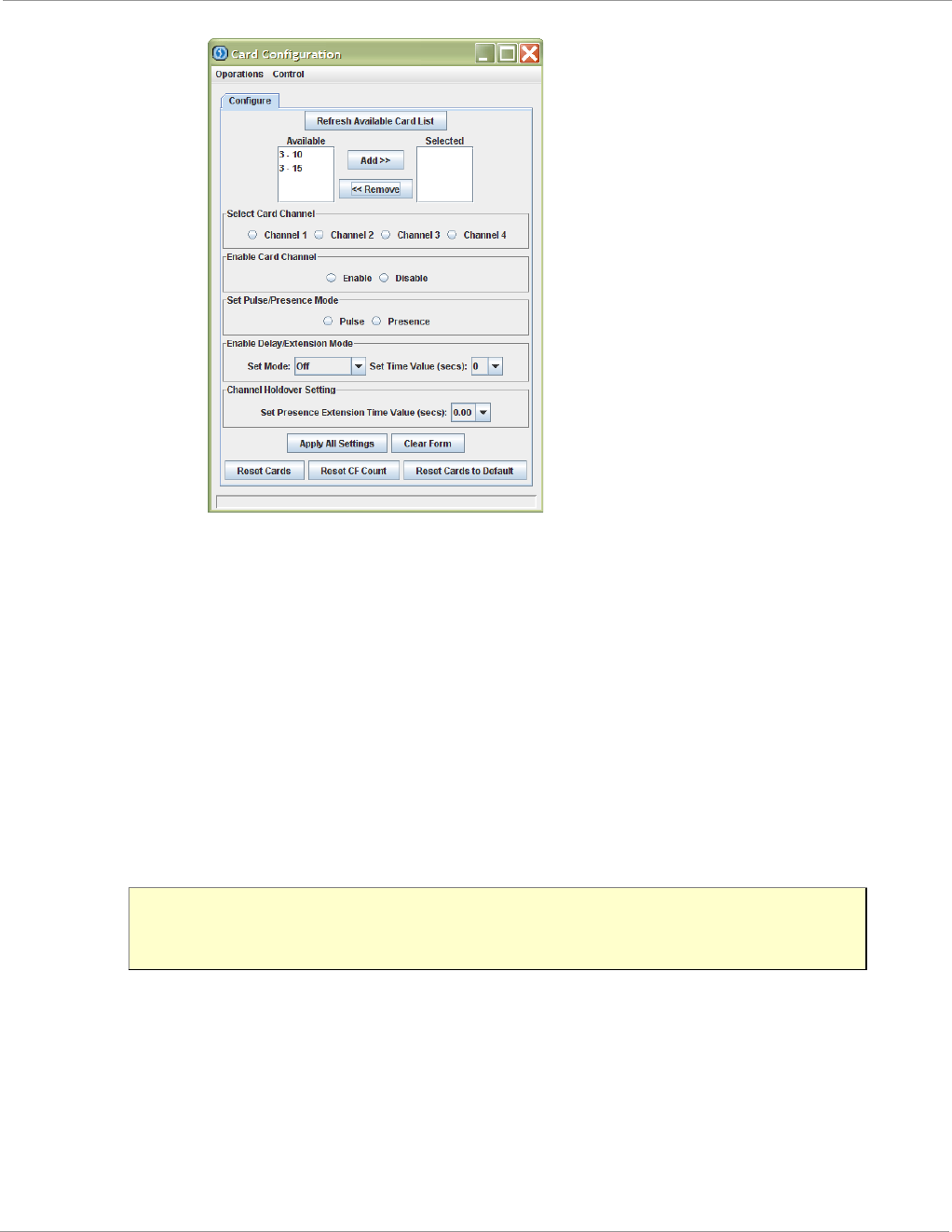
Access Point Controller Card Installation Guide Configuration
Figure 7.12 – Card Configuration window
Specifying the Elements of the Configuration
Specifying the elements of a contact closure card's configuration with TrafficDot involves the
following:
•Selecting an APCC or EX card
•Selecting a channel
•Enabling (or disabling) a channel
•Specifying the channel mode
•Setting a presence mode modifier (optional)
Note: Enabling the audible channel status monitor is not supported with TrafficDot. Use front-
panel dip switch 2 to select this option as described in the section Configuring Channels With
the Front-Panel Interface above.
Selecting an APCC or EX Card to Configure
Before configuration can take place, a controller card must be selected. This is done by
populating the scrolling list area labeled Selected with the Card ID of the target controller cards.
Available APCC or EX Card
The controller cards in the network appear in a scrolling list area labeled Available.
Sensys Networks, Inc. - 40 -

Access Point Controller Card Installation Guide Configuration
Figure 7.13 – Selecting a Controller Card to configure
Selecting and De-selecting APCC or EX Card
Controller cards are selected by moving their Card IDs from the Available list to the
Selected list as follows:
1. From the Available list, click the Card ID of the target controller card.
2. Click the button labeled Add >>.
The Card ID appears in the Selected list.
To remove Card IDs from the Selected list, do the following:
1. From the Selected list, click the Card ID of the target controller card.
2. Click << Remove.
The Card ID is removed from the Selected list and appears in the Available list.
Selecting a Channel
The window area Select Card Channel displays radio buttons that correspond to the available
channels on the controller card.
Figure 7.14 – Selecting a controller card channel
Select a channel to configure by clicking the radio button that appears to the left of the channel
name. Only one channel may be selected.
Enabling and Disabling a Channel
The window area Enable/Disable Card Channel displays radio buttons that enable or disable
the selected channel.
To enable the channel, click the radio button displayed to the left of the Enable label.
To disable the channel, click the radio button displayed to the left of the Disable label.
Sensys Networks, Inc. - 41 -

Access Point Controller Card Installation Guide Configuration
Specifying the Channel Mode
The window area Set Pulse/Presence Mode displays radio buttons that define the operating
mode of the selected channel.
To select pulse mode, click the radio button displayed to the left of the Pulse label.
To select presence mode, click the radio button displayed to the left of the Presence label.
Setting a Presence Mode Modifier (Optional)
Channels operating in presence mode may be tuned through the use of a modifier. The window
area Enable Delay/Extension Mode provides the following options:
•Delay, Delay16+ – delays the onset of the contact closure by n seconds
•Extension – extends the length of a contact closure by n seconds
Delay
The implementation of delay uses two settings to maintain consistency with front-panel
operations in regard to this setting. The first setting, Delay, allows the duration of the delay
to be set between 0 and 15 seconds. The second, Delay16+, allows the duration to be set
between 16 and 31 seconds.
Extension
Extension is implemented as a duration between 0 and 7.5 seconds, in .05 second
increments.
To set a delay, select either Delay or Delay16+ from the Set Mode drop-down list. To set an
extension, select Extension/2 from the Set Mode drop-down list.
The values of the Set Time Value (secs) automatically adjust based on the selection of either
delay or extension.
Figure 7.15 – Setting Delay or Extension for presence mode channels
Select an entry from both the Set Mode and Set Time Value (secs) drop-down lists.
Sensys Networks, Inc. - 42 -

Access Point Controller Card Installation Guide Configuration
Off
Select the Off value from the Set Mode drop-down list for channels in pulse mode, or for
channels in presence mode that do not require a modification to their default behavior.
Channel Holdover Setting
This feature is not intended for customer use; set this value to zero.
Saving the Configuration
After configuration settings have been specified, save the configuration to device memory. Click
Apply All Settings to save the configuration.
Figure 7.16 – Saving the configuration
Other Card Configuration Operations
The Card Configuration window provides other useful operations related to contact closure cards.
Command buttons at the bottom of the window perform the following:
•Reset Cards – sends a hardware reset command to each of the cards in the Selected list
•Reset CF Count – zeros the checksum failure counter on each of the cards in the
Selected list.
•Reset Cards to Default – resets all cards in the Selected list to the factory default
settings.
The Control menu includes an Identify Card option that when clicked causes a card's Link LED to
blink rapidly for five seconds. This allows field service staff to easily match a card from the Selected
list to the actual (physical) cards in a cabinet.
Defining Sensor-to-Channel Mappings
A database stored on the access point describes the associations between sensors and channels on
the contact closure cards. This database – known as the Dot Table – is maintained with TrafficDot,
Sensys Network's system management tool.
Sensys Networks, Inc. - 43 -
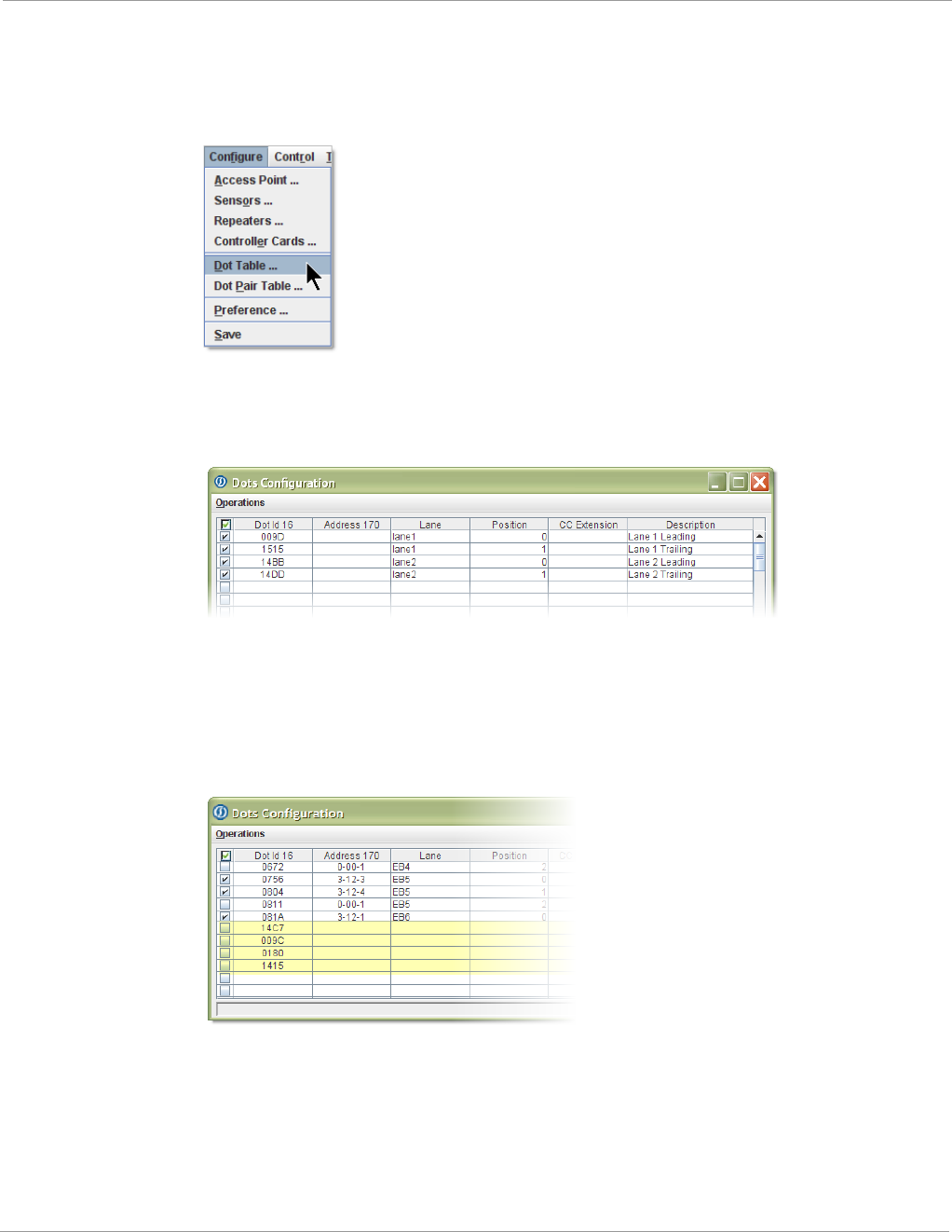
Access Point Controller Card Installation Guide Configuration
Enter the sensor-to-channel mappings by following these steps:
1. From the command menu on TrafficDot's main window, access Configure and
click Dot Table.
Figure 7.17– Configure | Dot Table menu
The Dots Configuration window opens. Depending on the status of your network the
window may or may not contain information.
Figure 7.18 – Dots Configuration window
2. From the Operations menu, select Populate.
The access point discovers all sensors in the network and add new entries to the table as
needed. New entries require completion by the end-user as shown in the figure below (see
sensors 14C7, 009C, 0180 and 1415).
Figure 7.19 – Dot Configuration entries added by Populate process
3. Using information from the channel mapping worksheet(s), complete an entry
for each sensor using the table and notes below as a guide.
Sensys Networks, Inc. - 44 -

Access Point Controller Card Installation Guide Configuration
Column Description
(Checkbox) Makes a sensor table entry active in the dot configuration. (
Required
)
DotId 16 Sensor ID (
Required
)
Address 170 Maps a sensor table entry to a contact closure card channel. (
Required
)
CC Extension Specifies a channel extension duration in 1/1024 seconds for this sensor only. (
Optional )
Table 4: Dot Configuration Elements
Notes
•Fill the checkbox to indicate that the dot table entry is active for the
configuration. (Note: this element has no effect on the actual detection
behavior of a sensor.)
•Sensor IDs may be added via the populate menu command or manually typed
into the table.
•Address 170 entries are required and must adhere to the following form:
shelf number – slot number – channel
where shelf number – slot number is a Card ID associated with a contact closure
master or extension card and channel is between 1 and 4.
•Lane, Position, and Description are not required to map sensors to channels.
4. After completing the mapping entries, save the dot configuration to the access
point. From the Operations menu, click Apply.
A progress window appears as the configuration is saved. When the progress window
closes, the dot configuration table has been saved to the access point.
Exiting TrafficDot
End the TrafficDot session by disconnecting from the access point as follows:
1. From the Connect menu, click Disconnect.
2. From the Connect menu, click Exit.
Sensys Networks, Inc. - 45 -

Access Point Controller Card Installation Guide Appendixes
Appendixes
Sensys Networks, Inc. - 46 -
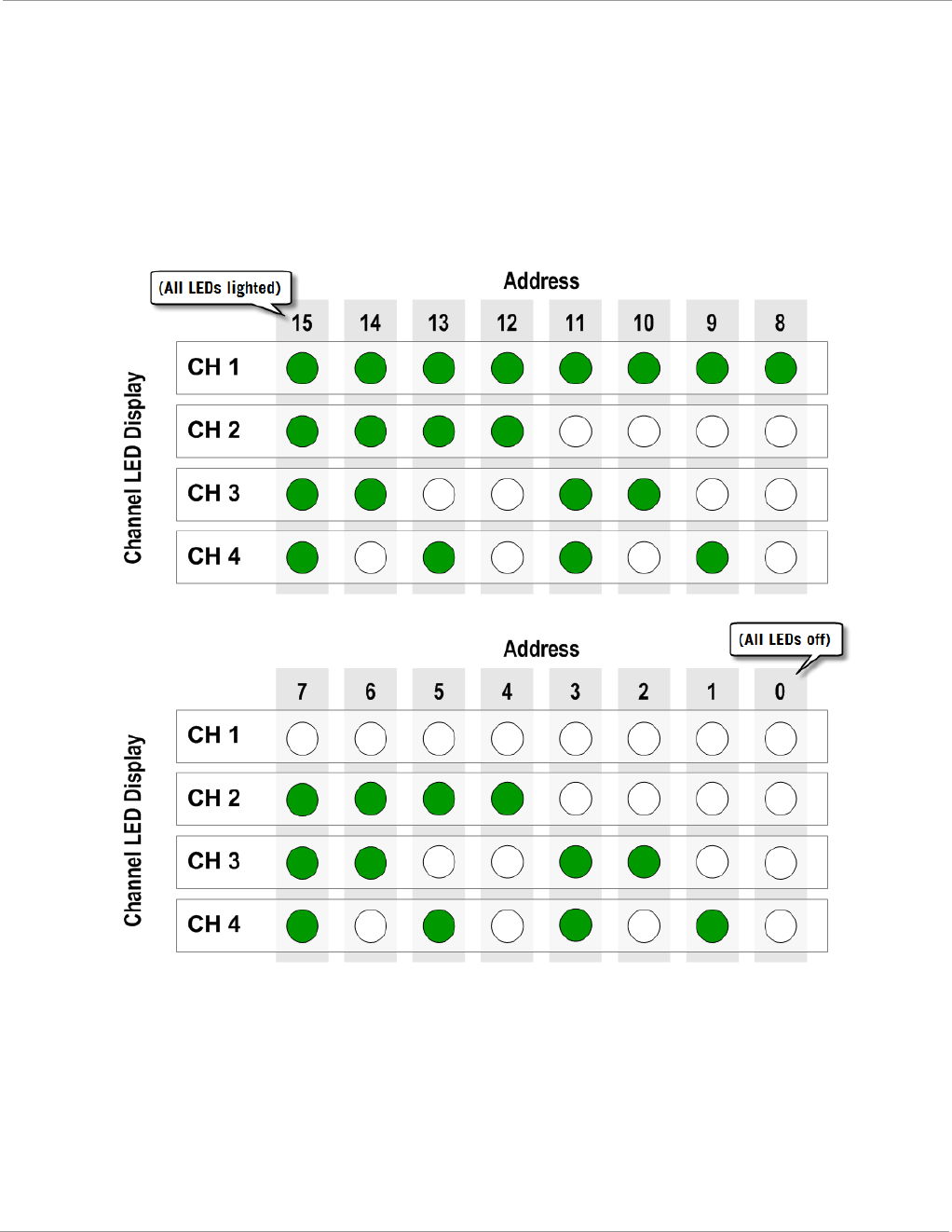
Access Point Controller Card Installation Guide Appendixes
Appendix 1 – X Mode LED Displays for Slot Numbers
This appendix depicts the channel LED displays when an APCC operates in X mode.
When a card is configured in X mode, the front-panel channel LEDs display one of the patterns
shown in the figure below. Match the pattern of the front-panel channel LEDs to a pattern in the
figure. Use the corresponding value found under the heading Address as the slot-number portion of
the Card ID. (See examples beneath the figure.)
Figure A1 – Channel LED display / slot number combinations
Examples
1. All fours channel LEDs lighted indicates slot number 15.
2. Single lighted LED on channel 2 indicates slot number 4.
Sensys Networks, Inc. - 47 -

Access Point Controller Card Installation Guide Appendixes
Appendix 2 – Circuit-board Dip Switch SW1 Settings
This appendix depicts combinations of switch settings on the circuit-board dip switch SW1.
Settings for Shelf Number
The figure below depicts SW1 settings that identify the shelf number portion of the unique card
address. (Note: the small, slide switches are referred to by number [1-4] starting with the left-most
switch. Switches three and four of SW1 are not used in setting the shelf number.)
Figure A2.1 – SW1 settings for Shelf Number (switches 1 and 2 only)
Settings for TS1 and TS2 Controllers
The figure below depicts SW1 settings that identify the type of traffic controller. Type 170 and TS1
controllers are set the same way.
Figure A2.2 – SW1 settings for TS controller types (switch 3 only)
(Note: slide switches one, two and four are not used in setting the controller type.)
Sensys Networks, Inc. - 48 -

Access Point Controller Card Installation Guide Appendixes
Appendix 3 – Circuit-board Dip Switch SW2 Settings
This appendix depicts combinations of switch settings on the circuit-board dip switch SW2.
Settings for Slot Number
Circuit-board switch SW2 is used to designate the slot number portion of a contact closure card's
Card ID. The switch combinations and the slot number values they represent are shown below.
(Slot number values appear beneath the switches.)
Figure A3.1 – SW2 Settings for Slot Number
Sensys Networks, Inc. - 49 -

Access Point Controller Card Installation Guide Appendixes
Appendix 4 – Pre-Installation Worksheets
This appendix provides worksheets for capturing pre-installation information. Refer to the chapter
Installation Considerations for more information.
Channel Configuration Worksheet
Configuration Element Options Value
1. Card identifier
(Defined by the traffic controller or installer)
2. Channel 1, 2, 3, 4
3. Channel State Enabled | Disabled
4. Channel Mode Pulse | Presence
4a. Presence Mode Modifier
(applicable only to channels in presence mode)
4b. Modifier Type None | Delay | Expansion
4c. Modifier Duration 0 – 31 seconds in 1 sec increments (
Delay
)
0 – 7.5 seconds in 0.5 second increments (
Expansion
)
5. Channel Holdover Setting 0 - .75 seconds in .05 second increments
6. Channel Status Communications LED-only | LED and Tone
Other Information (Optional)
Access Point identifier
(from Access Point)
Distance from Sensys Access Point 328 feet (100 meters) - 10BaseT
List of Wireless Sensor for the Channel
(use SensorIDs of each sensor)
Table 5: Channel Configuration Worksheet
Sensor-to-Channel Mapping Worksheet
Card ID Channel (1 - 4) Sensor ID Channel Extension (opt.) Location / Lane / Description (opt.)
Table 6: Sensor-to-Channel Mapping Worksheet
Sensys Networks, Inc. - 50 -